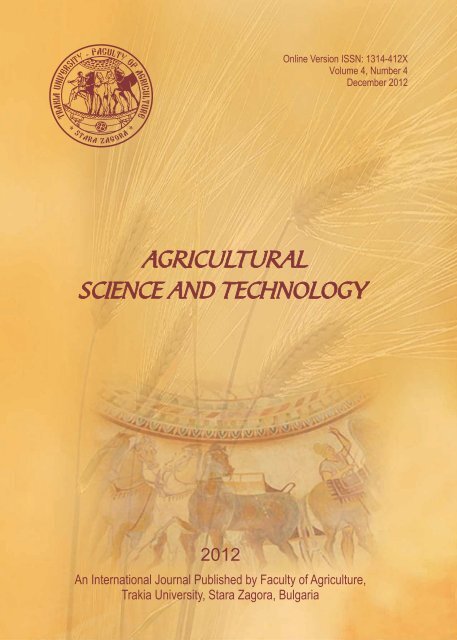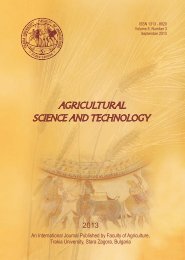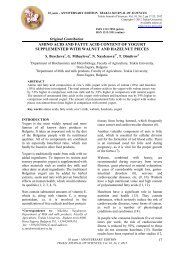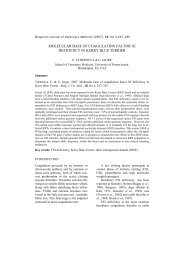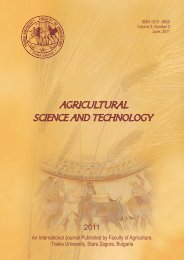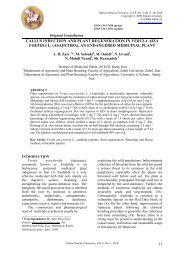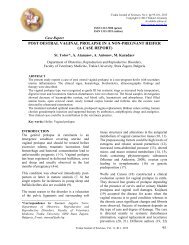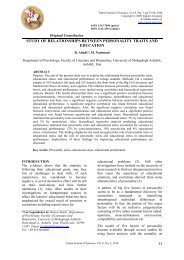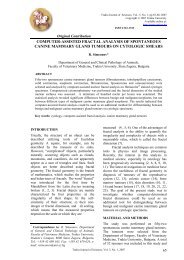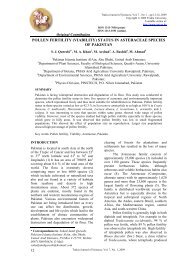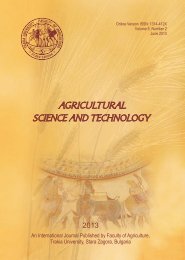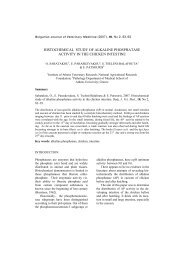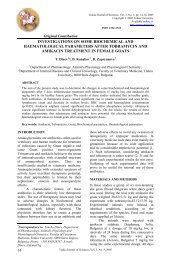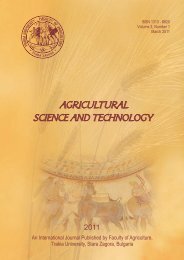Evapotranspiration of sunflower crops depending on irrigation
Evapotranspiration of sunflower crops depending on irrigation
Evapotranspiration of sunflower crops depending on irrigation
You also want an ePaper? Increase the reach of your titles
YUMPU automatically turns print PDFs into web optimized ePapers that Google loves.
Online Versi<strong>on</strong> ISSN: 1314-412X<br />
Volume 4, Number 4<br />
December 2012<br />
2012
Editor-in-Chief<br />
Tsanko Yablanski<br />
Faculty <str<strong>on</strong>g>of</str<strong>on</strong>g> Agriculture<br />
Trakia University, Stara Zagora<br />
Bulgaria<br />
Co-Editor-in- Chief<br />
Radoslav Slavov<br />
Faculty <str<strong>on</strong>g>of</str<strong>on</strong>g> Agriculture<br />
Trakia University, Stara Zagora<br />
Bulgaria<br />
Editors and Secti<strong>on</strong>s<br />
Genetics and Breading<br />
Atanas Atanasov (Bulgaria)<br />
Ihsan Soysal (Turkey)<br />
Max Rothschild (USA)<br />
Stoicho Metodiev (Bulgaria)<br />
Nutriti<strong>on</strong> and Physiology<br />
Nikolai Todorov (Bulgaria)<br />
Peter Surai (UK)<br />
Zervas Georgios (Greece)<br />
Ivan Varlyakov (Bulgaria)<br />
Producti<strong>on</strong> Systems<br />
Dimitar Pavlov (Bulgaria)<br />
Dimitar Panaiotov (Bulgaria)<br />
Banko Banev (Bulgaria)<br />
Georgy Zhelyazkov (Bulgaria)<br />
Agriculture and Envir<strong>on</strong>ment<br />
Georgi Petkov (Bulgaria)<br />
Ramesh Kanwar (USA)<br />
Product Quality and Safety<br />
Marin Kabakchiev (Bulgaria)<br />
Stefan Denev (Bulgaria)<br />
Vasil Atanasov (Bulgaria)<br />
English Editor<br />
Yanka Ivanova (Bulgaria)<br />
Scope and policy <str<strong>on</strong>g>of</str<strong>on</strong>g> the journal<br />
Agricultural Science and Technology /AST/<br />
– an Internati<strong>on</strong>al Scientific Journal <str<strong>on</strong>g>of</str<strong>on</strong>g><br />
Agricultural and Technology Sciences is<br />
published in English in <strong>on</strong>e volume <str<strong>on</strong>g>of</str<strong>on</strong>g> 4<br />
issues per year, as a printed journal and in<br />
electr<strong>on</strong>ic form. The policy <str<strong>on</strong>g>of</str<strong>on</strong>g> the journal is<br />
to publish original papers, reviews and<br />
short communicati<strong>on</strong>s covering the<br />
aspects <str<strong>on</strong>g>of</str<strong>on</strong>g> agriculture related with life<br />
sciences and modern technologies. It will<br />
<str<strong>on</strong>g>of</str<strong>on</strong>g>fer opportunities to address the global<br />
needs relating to food and envir<strong>on</strong>ment,<br />
health, exploit the technology to provide<br />
innovative products and sustainable<br />
development. Papers will be c<strong>on</strong>sidered in<br />
aspects <str<strong>on</strong>g>of</str<strong>on</strong>g> both fundamental and applied<br />
science in the areas <str<strong>on</strong>g>of</str<strong>on</strong>g> Genetics and<br />
Breeding, Nutriti<strong>on</strong> and Physiology,<br />
Producti<strong>on</strong> Systems, Agriculture and<br />
Envir<strong>on</strong>ment and Product Quality and<br />
Safety. Other categories closely related to<br />
the above topics could be c<strong>on</strong>sidered by<br />
the editors. The detailed informati<strong>on</strong> <str<strong>on</strong>g>of</str<strong>on</strong>g> the<br />
journal is available at the website.<br />
Proceedings <str<strong>on</strong>g>of</str<strong>on</strong>g> scientific meetings and<br />
c<strong>on</strong>ference reports will be c<strong>on</strong>sidered for<br />
special issues.<br />
Submissi<strong>on</strong> <str<strong>on</strong>g>of</str<strong>on</strong>g> Manuscripts<br />
All manuscript written in English should be<br />
submitted as MS-Word file attachments via<br />
e-mail to ascitech@uni-sz.bg. Manuscripts<br />
must be prepared strictly in accordance<br />
with the detailed instructi<strong>on</strong>s for authors at<br />
the website<br />
http://www.uni-sz.bg/ascitech/index.html<br />
and the instructi<strong>on</strong>s <strong>on</strong> the last page <str<strong>on</strong>g>of</str<strong>on</strong>g> the<br />
journal. For each manuscript the<br />
signatures <str<strong>on</strong>g>of</str<strong>on</strong>g> all authors are needed<br />
c<strong>on</strong>firming their c<strong>on</strong>sent to publish it and to<br />
nominate <strong>on</strong> author for corresp<strong>on</strong>dence.<br />
They have to be presented by a<br />
submissi<strong>on</strong> letter signed by all authors.<br />
The form <str<strong>on</strong>g>of</str<strong>on</strong>g> the submissi<strong>on</strong> letter is<br />
available up<strong>on</strong> from request from the<br />
Technical Assistance or could be<br />
downloaded from the website <str<strong>on</strong>g>of</str<strong>on</strong>g> the<br />
journal. All manuscripts are subject to<br />
editorial review and the editors reserve the<br />
right to improve style and return the paper<br />
for rewriting to the authors, if necessary.<br />
The editorial board reserves rights to reject<br />
manuscripts based <strong>on</strong> priorities and space<br />
availability in the journal.<br />
Internet Access<br />
This journal is included in the Trakia<br />
University Journals <strong>on</strong>line Service which<br />
can be found at www.uni-sz.bg.<br />
Address <str<strong>on</strong>g>of</str<strong>on</strong>g> Editorial <str<strong>on</strong>g>of</str<strong>on</strong>g>fice:<br />
Agricultural Science and Technology<br />
Faculty <str<strong>on</strong>g>of</str<strong>on</strong>g> Agriculture, Trakia University<br />
Student's campus, 6000 Stara Zagora<br />
Bulgaria<br />
Teleph<strong>on</strong>e.: +359 42 699330<br />
+359 42 699446<br />
http://www.uni-sz.bg/ascitech/index.html<br />
Technical Assistance:<br />
Nely Tsvetanova<br />
Teleph<strong>on</strong>e.: +359 42 699446<br />
E-mail: ascitech@uni-sz.bg
Online Versi<strong>on</strong> ISSN: 1314-412X<br />
Volume 4, Number 4<br />
December 2012<br />
2012
AGRICULTURAL SCIENCE AND TECHNOLOGY, VOL. 4, No 4, pp 417 - 426, 2012<br />
<str<strong>on</strong>g>Evapotranspirati<strong>on</strong></str<strong>on</strong>g> <str<strong>on</strong>g>of</str<strong>on</strong>g> <str<strong>on</strong>g>sunflower</str<strong>on</strong>g> <str<strong>on</strong>g>crops</str<strong>on</strong>g> <str<strong>on</strong>g>depending</str<strong>on</strong>g> <strong>on</strong> irrigati<strong>on</strong><br />
A. Matev*, R. Petrova, H. Kirchev<br />
Department <str<strong>on</strong>g>of</str<strong>on</strong>g> Meliorati<strong>on</strong> with Geodesy, Faculty <str<strong>on</strong>g>of</str<strong>on</strong>g> Viticulture and Horticulture, Agricultural University Plovdiv,12 Mendeleev, 4000 Plovdiv, Bulgaria<br />
Abstract. The aim <str<strong>on</strong>g>of</str<strong>on</strong>g> the study is to analyze the influence <str<strong>on</strong>g>of</str<strong>on</strong>g> irrigati<strong>on</strong> regime <strong>on</strong> evapotranspirati<strong>on</strong> (ET) <str<strong>on</strong>g>of</str<strong>on</strong>g> <str<strong>on</strong>g>sunflower</str<strong>on</strong>g>, in terms <str<strong>on</strong>g>of</str<strong>on</strong>g> total and average daily values,<br />
its effectiveness in terms <str<strong>on</strong>g>of</str<strong>on</strong>g> yield, and the peculiarities <str<strong>on</strong>g>of</str<strong>on</strong>g> its formati<strong>on</strong>. The field experiment was c<strong>on</strong>ducted in the regi<strong>on</strong> <str<strong>on</strong>g>of</str<strong>on</strong>g> Plovdiv, with hybrid PR-64-E-83. The<br />
variants <str<strong>on</strong>g>of</str<strong>on</strong>g> the study are: without irrigati<strong>on</strong>, optimal irrigati<strong>on</strong> with initial humidity at 75% <str<strong>on</strong>g>of</str<strong>on</strong>g> FC for the layer 0–80 cm and irrigati<strong>on</strong> with 50% and 150 % <str<strong>on</strong>g>of</str<strong>on</strong>g><br />
irrigati<strong>on</strong> rate, respectively. Seas<strong>on</strong>al evapotranspirati<strong>on</strong> <str<strong>on</strong>g>of</str<strong>on</strong>g> <str<strong>on</strong>g>sunflower</str<strong>on</strong>g> varies from 274 to 342 mm. Irrigati<strong>on</strong> with 50% <str<strong>on</strong>g>of</str<strong>on</strong>g> the optimal irrigati<strong>on</strong> depth causes ET<br />
increasing with an average <str<strong>on</strong>g>of</str<strong>on</strong>g> 33.1% (from 26.1 to 37.4%). The optimally irrigated <str<strong>on</strong>g>sunflower</str<strong>on</strong>g> uses from 475 to 559 mm. Increase <str<strong>on</strong>g>of</str<strong>on</strong>g> ET as compared with the<br />
rainfed <str<strong>on</strong>g>sunflower</str<strong>on</strong>g> is an average <str<strong>on</strong>g>of</str<strong>on</strong>g> 67%. In case <str<strong>on</strong>g>of</str<strong>on</strong>g> irrigati<strong>on</strong> with 150% <str<strong>on</strong>g>of</str<strong>on</strong>g> the irrigati<strong>on</strong> depth ET increases with extra 2.5 – 26.7% (an average <str<strong>on</strong>g>of</str<strong>on</strong>g> 13.5%). ET <str<strong>on</strong>g>of</str<strong>on</strong>g><br />
<str<strong>on</strong>g>sunflower</str<strong>on</strong>g> was formed in the following way for the c<strong>on</strong>diti<strong>on</strong>s <str<strong>on</strong>g>of</str<strong>on</strong>g> the experiment: In rain-fed c<strong>on</strong>diti<strong>on</strong>s rainfalls share 49 – 82% and water supply – from 18 to<br />
51% <str<strong>on</strong>g>of</str<strong>on</strong>g> ET. By irrigati<strong>on</strong> with 50% <str<strong>on</strong>g>of</str<strong>on</strong>g> rate the sharing <str<strong>on</strong>g>of</str<strong>on</strong>g> rainfalls is 36-64%, for water supply is 17-33% and irrigati<strong>on</strong> depth – 14-31%. By optimum irrigati<strong>on</strong><br />
sharing is respectively 28-56%, 16-23% and 25-49%. The maximum value <str<strong>on</strong>g>of</str<strong>on</strong>g> daily ET for rainfed <str<strong>on</strong>g>sunflower</str<strong>on</strong>g> varying from 3.3 to 5.6 mm. Irrigati<strong>on</strong> with norm <str<strong>on</strong>g>of</str<strong>on</strong>g><br />
50% increases values <str<strong>on</strong>g>of</str<strong>on</strong>g> ET to 5.2 – 6.1 mm. The maximal value <str<strong>on</strong>g>of</str<strong>on</strong>g> this regime <str<strong>on</strong>g>of</str<strong>on</strong>g> irrigati<strong>on</strong> is most <str<strong>on</strong>g>of</str<strong>on</strong>g>ten in the flowering period. In case <str<strong>on</strong>g>of</str<strong>on</strong>g> optimal irrigati<strong>on</strong> the<br />
maximal values <str<strong>on</strong>g>of</str<strong>on</strong>g> daily ET will remain the same usually to the beginning <str<strong>on</strong>g>of</str<strong>on</strong>g> phase „seeds fill”, and the values are between 6 and 7 mm.<br />
Keywords: <str<strong>on</strong>g>sunflower</str<strong>on</strong>g>, evaportanspirari<strong>on</strong>, water deficit, irrigati<strong>on</strong><br />
Introducti<strong>on</strong><br />
Sunflower is a crop c<strong>on</strong>suming significant amounts <str<strong>on</strong>g>of</str<strong>on</strong>g> water to<br />
form a unit yield. Obtaining maximum yields for the specific growing<br />
c<strong>on</strong>diti<strong>on</strong>s and the specific hybrid is related to the provisi<strong>on</strong> <str<strong>on</strong>g>of</str<strong>on</strong>g> the<br />
water to be c<strong>on</strong>sumed by plants from sowing until the seeds mature.<br />
During the vegetati<strong>on</strong> period a plant c<strong>on</strong>sumes between 500 and<br />
600 mm <str<strong>on</strong>g>of</str<strong>on</strong>g> water, with rainfall (for the period April-September) rarely<br />
exceeding 250-350 mm, i.e. irrigati<strong>on</strong> must ensure the rest <str<strong>on</strong>g>of</str<strong>on</strong>g> the<br />
evapotranspirati<strong>on</strong> (ET). According to Göksoy et al. (2004) and<br />
Demir et al. (2006) different irrigati<strong>on</strong> regimes have significant effect<br />
<strong>on</strong> aggregate evapotranspirati<strong>on</strong> <str<strong>on</strong>g>of</str<strong>on</strong>g> <str<strong>on</strong>g>sunflower</str<strong>on</strong>g>, and with an optimal<br />
irrigati<strong>on</strong> it can reach and exceed 670 mm. Whеn growing in the<br />
lysimeter at high air temperature, the crop ET can reach 765-882<br />
mm, and at the time <str<strong>on</strong>g>of</str<strong>on</strong>g> flowering it is possible to reach average daily<br />
values <str<strong>on</strong>g>of</str<strong>on</strong>g> 13 mm (Karam et al., 2007). For the regi<strong>on</strong> <str<strong>on</strong>g>of</str<strong>on</strong>g> Lavras<br />
(Brazil) ET <str<strong>on</strong>g>of</str<strong>on</strong>g> the optimally irrigated <str<strong>on</strong>g>sunflower</str<strong>on</strong>g> is 428.7 mm.<br />
Reducing irrigati<strong>on</strong> rates by 25% reduces its value down to 350.8<br />
mm. N<strong>on</strong>-irrigated <str<strong>on</strong>g>sunflower</str<strong>on</strong>g> c<strong>on</strong>sumes <strong>on</strong>ly 117.2 mm, and with an<br />
increase in the rate <str<strong>on</strong>g>of</str<strong>on</strong>g> 30% evapotranspirati<strong>on</strong> increased by about<br />
22%, although the yield was not significantly altered (Silva et al.,<br />
2007).<br />
<str<strong>on</strong>g>Evapotranspirati<strong>on</strong></str<strong>on</strong>g> <str<strong>on</strong>g>of</str<strong>on</strong>g> <str<strong>on</strong>g>sunflower</str<strong>on</strong>g> during the period from<br />
germinati<strong>on</strong> to bud formati<strong>on</strong> is not too intense, representing 20-<br />
25% <str<strong>on</strong>g>of</str<strong>on</strong>g> total value, however, the formati<strong>on</strong> <str<strong>on</strong>g>of</str<strong>on</strong>g> 3-6 pairs <str<strong>on</strong>g>of</str<strong>on</strong>g> leaves<br />
(when inflorescence is formed) is a critical period in terms <str<strong>on</strong>g>of</str<strong>on</strong>g> soil<br />
moisture. For the local c<strong>on</strong>diti<strong>on</strong>s, however, according to Delibaltov<br />
et al. (1973) natural humidity is enough for the normal growth in that<br />
period. The most intensive evapotranspirati<strong>on</strong> <str<strong>on</strong>g>of</str<strong>on</strong>g> <str<strong>on</strong>g>sunflower</str<strong>on</strong>g> plants is<br />
during the intensive linear growth (from bud formati<strong>on</strong> to full<br />
flowering) and during the flowering when for a period <str<strong>on</strong>g>of</str<strong>on</strong>g> 20-30 days<br />
they may form up to 55-60% <str<strong>on</strong>g>of</str<strong>on</strong>g> total evapotranspirati<strong>on</strong>, and during<br />
* e-mail: sa6_m@abv.bg<br />
the third period - about 25%. According to Mihov (1974), average<br />
daily evapotranspirati<strong>on</strong> <str<strong>on</strong>g>of</str<strong>on</strong>g> <str<strong>on</strong>g>sunflower</str<strong>on</strong>g> has the character <str<strong>on</strong>g>of</str<strong>on</strong>g> the curve<br />
with the following pattern: from germinati<strong>on</strong> to the first ten days <str<strong>on</strong>g>of</str<strong>on</strong>g><br />
May (including) it gradually increases from 1,0 to 2,1 mm. After this<br />
period the increase is much more intense and <str<strong>on</strong>g>depending</str<strong>on</strong>g> <strong>on</strong> the level<br />
<str<strong>on</strong>g>of</str<strong>on</strong>g> the soil moisture its values reach their respective maximum at<br />
different times. Under rainfed c<strong>on</strong>diti<strong>on</strong>s, the maximum daily<br />
average ET is 5.3 – 5.5 mm and is in the third decade <str<strong>on</strong>g>of</str<strong>on</strong>g> June. Under<br />
irrigated c<strong>on</strong>diti<strong>on</strong>s the maximum is within 7.5 – 7.7 mm and occurs<br />
in the sec<strong>on</strong>d decade <str<strong>on</strong>g>of</str<strong>on</strong>g> July. This coincides with the period <str<strong>on</strong>g>of</str<strong>on</strong>g> mass<br />
flowering and the start <str<strong>on</strong>g>of</str<strong>on</strong>g> grain ripening. After this period its values<br />
begin gradually to decrease due to the lower impact <str<strong>on</strong>g>of</str<strong>on</strong>g><br />
meteorological factors and gradual fading <str<strong>on</strong>g>of</str<strong>on</strong>g> physiological<br />
processes.<br />
The analysis <str<strong>on</strong>g>of</str<strong>on</strong>g> Ivanov (1972) for c<strong>on</strong>diti<strong>on</strong>s <str<strong>on</strong>g>of</str<strong>on</strong>g> low leached<br />
chernozem in Dobrudja showed that 46.5 to 48.0% <str<strong>on</strong>g>of</str<strong>on</strong>g> n<strong>on</strong>-irrigated<br />
<str<strong>on</strong>g>sunflower</str<strong>on</strong>g> ET is formed by precipitati<strong>on</strong>, and the rest – from the<br />
autumn-winter humidity. According to this author, the coefficient <str<strong>on</strong>g>of</str<strong>on</strong>g><br />
the <str<strong>on</strong>g>sunflower</str<strong>on</strong>g> evapotranspirati<strong>on</strong> to obtain 1 kg seeds with optimal<br />
moisture is 1.38 – 1.56 mm, and for 1 kg <str<strong>on</strong>g>of</str<strong>on</strong>g> oil – 2.92 – 3.23 mm. By<br />
improving the selecti<strong>on</strong> and introducti<strong>on</strong> <str<strong>on</strong>g>of</str<strong>on</strong>g> new high-yield hybrids,<br />
ET productivity increases significantly, and according to Demir, et al.<br />
(2006) 1 mm evapotranspirati<strong>on</strong> corresp<strong>on</strong>ds to 7.8 kg/ha yields.<br />
In recent years, <str<strong>on</strong>g>sunflower</str<strong>on</strong>g> has again become a favorite field<br />
crop for growing. This is a prerequisite for experiments related to the<br />
optimizati<strong>on</strong> <str<strong>on</strong>g>of</str<strong>on</strong>g> irrigati<strong>on</strong> <str<strong>on</strong>g>of</str<strong>on</strong>g> the crop and for obtaining the highest<br />
possible yields in the presence <str<strong>on</strong>g>of</str<strong>on</strong>g> limited water resources. An<br />
integral part <str<strong>on</strong>g>of</str<strong>on</strong>g> this type <str<strong>on</strong>g>of</str<strong>on</strong>g> studies is evapotranspirati<strong>on</strong> as a major<br />
c<strong>on</strong>sumpti<strong>on</strong> element in the soil water balance. The aim <str<strong>on</strong>g>of</str<strong>on</strong>g> the study<br />
is to analyze the influence <str<strong>on</strong>g>of</str<strong>on</strong>g> irrigati<strong>on</strong> regime <strong>on</strong> evapotranspirati<strong>on</strong><br />
<str<strong>on</strong>g>of</str<strong>on</strong>g> <str<strong>on</strong>g>sunflower</str<strong>on</strong>g>, in terms <str<strong>on</strong>g>of</str<strong>on</strong>g> total and average daily values, its<br />
effectiveness in terms <str<strong>on</strong>g>of</str<strong>on</strong>g> yield, and the peculiarities <str<strong>on</strong>g>of</str<strong>on</strong>g> its formati<strong>on</strong>.<br />
417
Material and methods<br />
a rectangular coordinate system for each period including the time<br />
between two soil samples. Between them, the curve <str<strong>on</strong>g>of</str<strong>on</strong>g> ET is drawn<br />
The analysis <str<strong>on</strong>g>of</str<strong>on</strong>g> the influence <str<strong>on</strong>g>of</str<strong>on</strong>g> irrigati<strong>on</strong> regime <strong>on</strong> so that after drawing a line between it and the X-axis to obtain the<br />
evapotranspirati<strong>on</strong> <str<strong>on</strong>g>of</str<strong>on</strong>g> <str<strong>on</strong>g>sunflower</str<strong>on</strong>g> was based <strong>on</strong> data from field amount equal to the total ET.<br />
experiment c<strong>on</strong>ducted in the period 2004 – 2010 (excluding 2005) in Productivity <str<strong>on</strong>g>of</str<strong>on</strong>g> evapotranspirati<strong>on</strong> has been established in two<br />
the regi<strong>on</strong> <str<strong>on</strong>g>of</str<strong>on</strong>g> experimental training field <str<strong>on</strong>g>of</str<strong>on</strong>g> Department <str<strong>on</strong>g>of</str<strong>on</strong>g> Surveying ways: 1) ET (mm) to obtain a yield <str<strong>on</strong>g>of</str<strong>on</strong>g> 1kg/ha; 2) yield (kg/ha) for 1 mm<br />
and Land Reclamati<strong>on</strong>, Agrarian University, Plovdiv, <strong>on</strong> alluvial ET. During the years <str<strong>on</strong>g>of</str<strong>on</strong>g> the experiment all major agricultural events<br />
meadow soils (formerly waterlogged). According to Meranzova were observed related to technology adopted for the country for<br />
(1990) characteristics <str<strong>on</strong>g>of</str<strong>on</strong>g> the soil in the experimental field are: density growing the specific crop.<br />
FC<br />
max<br />
α = 1.39 t/m3; d= 29.4 (humidity at field capacity (FC), %); W =<br />
min<br />
326.9 mm; W = 245.2 mm (with 75% <str<strong>on</strong>g>of</str<strong>on</strong>g> FC).<br />
The experiment was carried out with hybrid PR-64-E-83, crop Results and discussi<strong>on</strong><br />
density <str<strong>on</strong>g>of</str<strong>on</strong>g> 5500 plants per acre and row spacing <str<strong>on</strong>g>of</str<strong>on</strong>g> 70cm. The<br />
variants relating to this study are: 1) without irrigati<strong>on</strong>, 2) irrigati<strong>on</strong> <str<strong>on</strong>g>Evapotranspirati<strong>on</strong></str<strong>on</strong>g> <str<strong>on</strong>g>of</str<strong>on</strong>g> each crop, including <str<strong>on</strong>g>sunflower</str<strong>on</strong>g> is<br />
with 50% <str<strong>on</strong>g>of</str<strong>on</strong>g> irrigati<strong>on</strong> rate calculated for the optimal variant, 3) significantly influenced by the meteorological c<strong>on</strong>diti<strong>on</strong>s <str<strong>on</strong>g>of</str<strong>on</strong>g> the year<br />
optimal irrigati<strong>on</strong> with initial humidity at 75% <str<strong>on</strong>g>of</str<strong>on</strong>g> FC for the layer 0-80 (rainfall, temperature and humidity deficit <str<strong>on</strong>g>of</str<strong>on</strong>g> the air). In terms <str<strong>on</strong>g>of</str<strong>on</strong>g><br />
cm; 4) irrigati<strong>on</strong> 150% <str<strong>on</strong>g>of</str<strong>on</strong>g> irrigati<strong>on</strong> rate. In 2004, the opti<strong>on</strong>s are as precipitati<strong>on</strong> 2004, 2006, 2008 and 2010 are c<strong>on</strong>sidered average<br />
follows: no irrigati<strong>on</strong> and irrigati<strong>on</strong> rate 25, 50, 75 and 100%. The years. 2007 is c<strong>on</strong>sidered as very moist, but at the same time it is<br />
number <str<strong>on</strong>g>of</str<strong>on</strong>g> irrigati<strong>on</strong>s and time for their implementati<strong>on</strong> in all versi<strong>on</strong>s extremely dry in the critical periods <str<strong>on</strong>g>of</str<strong>on</strong>g> vegetati<strong>on</strong> <str<strong>on</strong>g>of</str<strong>on</strong>g> <str<strong>on</strong>g>sunflower</str<strong>on</strong>g>. With<br />
<str<strong>on</strong>g>of</str<strong>on</strong>g> the same experiment are the same and is fully in accordance with probability <str<strong>on</strong>g>of</str<strong>on</strong>g> 69.4%, 2009 can be defined as medium dry. With<br />
the requirements for optimal versi<strong>on</strong>, and an adjustment is made in respect to the average temperature, the first experimental year<br />
the amount <str<strong>on</strong>g>of</str<strong>on</strong>g> irrigati<strong>on</strong> norms. Irrigati<strong>on</strong> is d<strong>on</strong>e by gravity <strong>on</strong> short (2004) is a medium to medium cool, but 2007, 2009 and 2010 are<br />
closed furrows. The experiment is carried out with the block method very warm. Quite similar in meteorological terms are 2006 and 2008,<br />
2<br />
in four replicati<strong>on</strong>s with experimental plot area 30 m , and the harvest the same indicator characterizing them as moderately warm.<br />
2<br />
plot area – 10 m . The dynamics <str<strong>on</strong>g>of</str<strong>on</strong>g> soil moisture was m<strong>on</strong>itored in all Although it is very dynamic as values, the air humidity deficit is<br />
variants in 7 – 10 days layer by layer every 10 cm, depth <str<strong>on</strong>g>of</str<strong>on</strong>g> 1m, by the crucial for the intensity <str<strong>on</strong>g>of</str<strong>on</strong>g> ET, especially with a sufficient amount <str<strong>on</strong>g>of</str<strong>on</strong>g><br />
weighting method. The total ET was also calculated for all variants <str<strong>on</strong>g>of</str<strong>on</strong>g> available soil moisture. In respect <str<strong>on</strong>g>of</str<strong>on</strong>g> this indicator 2007 is very dry,<br />
the experiment through m<strong>on</strong>itoring the balance <str<strong>on</strong>g>of</str<strong>on</strong>g> water supply and 2004 is dry and 2010 is medium. The remaining three years <str<strong>on</strong>g>of</str<strong>on</strong>g> the<br />
loss in soil layer 0 – 80 cm. The balance incorporates water supply experiment are moderately dry. Data for providing the meteo-<br />
elements such as usable rainfall, determined by the method <str<strong>on</strong>g>of</str<strong>on</strong>g> rological factors that determine the ET are presented in Table 1. The<br />
successive approximati<strong>on</strong>s (Krafti, 1964), and irrigati<strong>on</strong> rates, if table also c<strong>on</strong>tains the total absolute values <str<strong>on</strong>g>of</str<strong>on</strong>g> each factor for the<br />
there was any irrigati<strong>on</strong> during the relevant period. The average rate period V – IX, and data <strong>on</strong> multi-year average values.<br />
<str<strong>on</strong>g>of</str<strong>on</strong>g> ET is determined by ten days, calculated ET values are mapped in<br />
Table1. Probability <str<strong>on</strong>g>of</str<strong>on</strong>g> precipitati<strong>on</strong>s, temperature and water pressure deficit in Plovdiv regi<strong>on</strong> for V - ІХ period<br />
Factor<br />
Average for multi year period<br />
All experimental years<br />
2004 2006 2007 2008 2009 2010<br />
ΣT°<br />
ΣD<br />
N<br />
°С<br />
P %<br />
HPa<br />
P %<br />
mm<br />
P %<br />
3181 °C (for 93 years)<br />
1430 HPa (for 74 years)<br />
241.9 mm (for 97 years)<br />
3135<br />
60.64<br />
1675<br />
13.33<br />
233.5<br />
44.90<br />
3239<br />
36.17<br />
1590<br />
21.33<br />
228.0<br />
50.00<br />
3367<br />
9.57<br />
1794<br />
6.67<br />
463.2<br />
2.04<br />
3243<br />
35.11<br />
1587<br />
22.67<br />
231.0<br />
45.92<br />
3326<br />
13.83<br />
1629<br />
18.67<br />
190.2<br />
69.39<br />
3331<br />
12.77<br />
1441<br />
50.67<br />
234.3<br />
43.88<br />
ΣT° – sum <str<strong>on</strong>g>of</str<strong>on</strong>g> temperature; ΣD – sum <str<strong>on</strong>g>of</str<strong>on</strong>g> water pressure deficit; N – precipitati<strong>on</strong>s;<br />
Р% – empirical probability <str<strong>on</strong>g>of</str<strong>on</strong>g> meteorological factors<br />
Seas<strong>on</strong>al (total) evapotranspirati<strong>on</strong><br />
<str<strong>on</strong>g>sunflower</str<strong>on</strong>g> to deal with short-term drought without significantly<br />
Apart from weather c<strong>on</strong>diti<strong>on</strong>s, ET depends <strong>on</strong> species and affecting its life processes also c<strong>on</strong>tributes for this minor variati<strong>on</strong>.<br />
variety characteristics <str<strong>on</strong>g>of</str<strong>on</strong>g> the <str<strong>on</strong>g>crops</str<strong>on</strong>g>, length <str<strong>on</strong>g>of</str<strong>on</strong>g> vegetati<strong>on</strong> period, as Although for the period 10 June to 31 July rainfall is <strong>on</strong>ly 4.2 mm,<br />
well as <strong>on</strong> the water regime in the active soil layer. Data <strong>on</strong> the 2007 is the wettest year <str<strong>on</strong>g>of</str<strong>on</strong>g> the experiment. Rainfall during the third<br />
influence <str<strong>on</strong>g>of</str<strong>on</strong>g> irrigati<strong>on</strong> regime <strong>on</strong> seas<strong>on</strong>al (total) evapotranspirati<strong>on</strong> decade <str<strong>on</strong>g>of</str<strong>on</strong>g> May (124 mm) and the first ten days <str<strong>on</strong>g>of</str<strong>on</strong>g> June (129.3 mm)<br />
<str<strong>on</strong>g>of</str<strong>on</strong>g> the tested <str<strong>on</strong>g>sunflower</str<strong>on</strong>g> hybrid are shown in Table 2. ensures sufficient moisture readily accessible till the start <str<strong>on</strong>g>of</str<strong>on</strong>g> the<br />
Despite the differences in meteorological terms, ET <str<strong>on</strong>g>of</str<strong>on</strong>g> n<strong>on</strong>-irrigated period <str<strong>on</strong>g>of</str<strong>on</strong>g> seed-fill. Under such c<strong>on</strong>diti<strong>on</strong>s, combined with high air<br />
<str<strong>on</strong>g>sunflower</str<strong>on</strong>g> in the different years <str<strong>on</strong>g>of</str<strong>on</strong>g> experiment varies in relatively temperatures and low relative humidity ET during the period <str<strong>on</strong>g>of</str<strong>on</strong>g> bud<br />
narrow range with the lowest values – in the averagely dry and hot formati<strong>on</strong>-flowering-growth <str<strong>on</strong>g>of</str<strong>on</strong>g> flower head is maximal and that<br />
2009 (274.4 mm). In the years with medium rainfall values (2004, coincides with the biological maximum <str<strong>on</strong>g>of</str<strong>on</strong>g> ET in <str<strong>on</strong>g>sunflower</str<strong>on</strong>g>. Therefore,<br />
2006, 2008 and 2010) ET ranged 302 – 331 mm. The ability <str<strong>on</strong>g>of</str<strong>on</strong>g> the total evapotranspirati<strong>on</strong> <str<strong>on</strong>g>of</str<strong>on</strong>g> rainfed <str<strong>on</strong>g>sunflower</str<strong>on</strong>g> in 2007 was<br />
418
Table 2. Seas<strong>on</strong>al evapotranspirati<strong>on</strong> <str<strong>on</strong>g>of</str<strong>on</strong>g> <str<strong>on</strong>g>sunflower</str<strong>on</strong>g> by variants and years. <str<strong>on</strong>g>Evapotranspirati<strong>on</strong></str<strong>on</strong>g> formati<strong>on</strong><br />
Variants<br />
ЕТ<br />
(mm)<br />
ET (relative)<br />
Precipitati<strong>on</strong>s Irrigati<strong>on</strong> depth Soil water<br />
to 0% to 100% mm % mm % mm %<br />
2004<br />
no irrigated<br />
25% m<br />
50% m<br />
75% m<br />
100% m<br />
no irrigated<br />
50% m<br />
100% m<br />
150% m<br />
330.8<br />
385.4<br />
417.2<br />
431.5<br />
499.9<br />
302.4<br />
394.6<br />
498.0<br />
630.9<br />
100.0<br />
116.5<br />
126.1<br />
130.4<br />
151.1<br />
100.0<br />
130.5<br />
164.7<br />
208.6<br />
66.2<br />
77.1<br />
83.5<br />
86.3<br />
100.0<br />
60.7<br />
79.2<br />
100.0<br />
126.7<br />
215.4<br />
215.4<br />
215.4<br />
215.4<br />
215.4<br />
2006<br />
172.3<br />
172.3<br />
172.3<br />
172.3<br />
65.1<br />
55.9<br />
51.6<br />
49.9<br />
43.1<br />
57.0<br />
43.7<br />
34.6<br />
27.3<br />
0.0<br />
54.3<br />
108.6<br />
162.9<br />
216.9<br />
0.0<br />
120.0<br />
240.0<br />
348.7<br />
0.0<br />
14.1<br />
26.0<br />
37.7<br />
43.4<br />
0.0<br />
30.4<br />
48.2<br />
55.3<br />
115.4<br />
115.7<br />
93.2<br />
53.2<br />
67.6<br />
130.1<br />
102.3<br />
85.7<br />
109.9<br />
34.9<br />
30.0<br />
22.4<br />
12.4<br />
13.5<br />
43.0<br />
25.9<br />
17.2<br />
17.4<br />
2007<br />
no irrigated<br />
50% m<br />
100% m<br />
150% m<br />
341.7<br />
437.5<br />
498.5<br />
571.6<br />
100.0<br />
128.0<br />
145.9<br />
167.3<br />
68.5<br />
87.8<br />
100.0<br />
114.7<br />
280.7<br />
280.7<br />
280.7<br />
280.7<br />
82.1<br />
64.2<br />
56.3<br />
49.1<br />
0.0<br />
62.3<br />
124.6<br />
186.9<br />
0.0<br />
14.2<br />
25.0<br />
32.7<br />
61.0<br />
94.5<br />
93.2<br />
104.0<br />
17.9<br />
21.6<br />
18.7<br />
18.2<br />
2008<br />
no irrigated<br />
50% m<br />
100% m<br />
150% m<br />
313.4<br />
430.5<br />
547.6<br />
592.8<br />
100.0<br />
137.4<br />
174.7<br />
189.2<br />
57.2<br />
78.6<br />
100.0<br />
108.3<br />
154.4<br />
154.4<br />
154.4<br />
153.0<br />
49.3<br />
35.9<br />
28.2<br />
25.8<br />
0.0<br />
134.9<br />
268.7<br />
333.2<br />
0.0<br />
31.3<br />
49.1<br />
56.2<br />
159.0<br />
141.2<br />
124.5<br />
106.6<br />
50.7<br />
32.8<br />
22.7<br />
18.0<br />
2009<br />
no irrigated<br />
50% m<br />
100% m<br />
150% m<br />
no irrigated<br />
50% m<br />
100% m<br />
150% m<br />
274.4<br />
374.5<br />
474.7<br />
486.8<br />
311.0<br />
416.4<br />
558.6<br />
643.3<br />
100.0<br />
136.5<br />
173.0<br />
177.4<br />
100.0<br />
133.9<br />
179.6<br />
206.8<br />
57.8<br />
78.9<br />
100.0<br />
102.5<br />
55.7<br />
74.5<br />
100.0<br />
115.2<br />
174.3<br />
174.3<br />
162.2<br />
148.5<br />
2010<br />
221.6<br />
221.6<br />
221.6<br />
207.8<br />
63.5<br />
46.5<br />
34.2<br />
30.5<br />
71.3<br />
53.2<br />
39.7<br />
32.3<br />
0.0<br />
115.7<br />
231.3<br />
257.1<br />
0.0<br />
123.6<br />
246.9<br />
342.1<br />
0.0<br />
30.9<br />
48.7<br />
52.8<br />
0.0<br />
29.7<br />
44.2<br />
53.2<br />
100.1<br />
84.5<br />
81.2<br />
81.2<br />
89.4<br />
71.2<br />
90.1<br />
93.4<br />
36.5<br />
22.6<br />
17.1<br />
16.7<br />
28.7<br />
17.1<br />
16.1<br />
14.5<br />
Average for 2006 – 2010<br />
no irrigated<br />
50% m<br />
100% m<br />
150% m<br />
308.6<br />
410.7<br />
515.5<br />
585.1<br />
100.0<br />
133.1<br />
167.0<br />
189.6<br />
59.9<br />
79.7<br />
100.0<br />
113.5<br />
200.7<br />
200.7<br />
198.2<br />
192.5<br />
65.0<br />
48.9<br />
38.4<br />
32.9<br />
0.0<br />
111.3<br />
222.3<br />
293.6<br />
0.0<br />
27.1<br />
43.1<br />
50.2<br />
107.9<br />
98.7<br />
95.0<br />
99.0<br />
35.0<br />
24.0<br />
18.5<br />
16.9<br />
*m – irrigati<strong>on</strong> rate<br />
comparatively higher than in other years and it is 341.7 mm. As an rate <str<strong>on</strong>g>of</str<strong>on</strong>g> 150%. There ET is over two times higher than n<strong>on</strong>-irrigated<br />
average for the whole period <str<strong>on</strong>g>of</str<strong>on</strong>g> experiment values for this opti<strong>on</strong> are variant in two <str<strong>on</strong>g>of</str<strong>on</strong>g> the experimental years. <str<strong>on</strong>g>Evapotranspirati<strong>on</strong></str<strong>on</strong>g> for<br />
308.6 mm. irrigati<strong>on</strong> by 50% <str<strong>on</strong>g>of</str<strong>on</strong>g> the estimated optimal irrigati<strong>on</strong> rate is influenced<br />
Partially or fully restoring the readily available moisture in the less by temperature c<strong>on</strong>diti<strong>on</strong>s, and its increase compared to n<strong>on</strong>active<br />
soil layer, irrigati<strong>on</strong> leads to increased ET, and hence its totals irrigated <str<strong>on</strong>g>sunflower</str<strong>on</strong>g> in different years ranged from 26.5 to 36.5%<br />
values. For experimental c<strong>on</strong>diti<strong>on</strong>s, with the improvement <str<strong>on</strong>g>of</str<strong>on</strong>g> water (average 33.1%). Changes are relatively c<strong>on</strong>stant for the optimal<br />
regime in irrigati<strong>on</strong> variants, there is a growing influence <str<strong>on</strong>g>of</str<strong>on</strong>g> variant, with the average relative increase <str<strong>on</strong>g>of</str<strong>on</strong>g> 67%. The increase in<br />
meteorological factors, very well expressed in variants with irrigati<strong>on</strong> the extreme 2007 (46%) is the smallest due to high absolute values<br />
419
<str<strong>on</strong>g>of</str<strong>on</strong>g> ET in n<strong>on</strong>-irrigated variant, <strong>on</strong> the <strong>on</strong>e hand, and because the<br />
irrigati<strong>on</strong> period begins <strong>on</strong>ly at the end <str<strong>on</strong>g>of</str<strong>on</strong>g> the period <str<strong>on</strong>g>of</str<strong>on</strong>g> full flowering<br />
and growth <str<strong>on</strong>g>of</str<strong>on</strong>g> the flower head and the number <str<strong>on</strong>g>of</str<strong>on</strong>g> irrigati<strong>on</strong>s is <strong>on</strong>e<br />
less. In the first experimental year the results are similar with two<br />
irrigati<strong>on</strong>s as well, respectively at the end <str<strong>on</strong>g>of</str<strong>on</strong>g> flowering and during the<br />
period <str<strong>on</strong>g>of</str<strong>on</strong>g> seed-fill. Given the results in Table 2 we can make two main<br />
c<strong>on</strong>clusi<strong>on</strong>s: 1) the impact <str<strong>on</strong>g>of</str<strong>on</strong>g> weather c<strong>on</strong>diti<strong>on</strong>s during the year is<br />
more important for the change <str<strong>on</strong>g>of</str<strong>on</strong>g> absolute values <str<strong>on</strong>g>of</str<strong>on</strong>g> ET, <str<strong>on</strong>g>depending</str<strong>on</strong>g><br />
<strong>on</strong> the water reserves; 2) as for the relative change <str<strong>on</strong>g>of</str<strong>on</strong>g> ET in different<br />
levels <str<strong>on</strong>g>of</str<strong>on</strong>g> water reserve, it is substantially influenced by the biology <str<strong>on</strong>g>of</str<strong>on</strong>g><br />
the crop, so they vary within smaller borders in years with different<br />
characteristics. In support <str<strong>on</strong>g>of</str<strong>on</strong>g> this opini<strong>on</strong> are the graphs presented in<br />
Figure 1, which depicts the relative change <str<strong>on</strong>g>of</str<strong>on</strong>g> total ET with<br />
increasing relative irrigati<strong>on</strong> rate, respectively, by year and average<br />
for the period <str<strong>on</strong>g>of</str<strong>on</strong>g> the experiment.<br />
Experimental data points for all experimental years are<br />
approximated by curves <str<strong>on</strong>g>of</str<strong>on</strong>g> sec<strong>on</strong>d degree representing c<strong>on</strong>vex<br />
2<br />
parabolas, and accuracy is very high (R > 0.95). The graph <str<strong>on</strong>g>of</str<strong>on</strong>g> Figure<br />
1 is intended rather to illustrate the small fluctuati<strong>on</strong> <str<strong>on</strong>g>of</str<strong>on</strong>g> the relative<br />
change <str<strong>on</strong>g>of</str<strong>on</strong>g> ET than to propose specific equati<strong>on</strong>s satisfying specific<br />
relati<strong>on</strong> to each <str<strong>on</strong>g>of</str<strong>on</strong>g> the experimental years. Figure 2 gives average<br />
values separately for all experimental points and their average<br />
values with sec<strong>on</strong>d-degree curves that almost coincide. The<br />
coefficient <str<strong>on</strong>g>of</str<strong>on</strong>g> determinati<strong>on</strong> for approximati<strong>on</strong> <str<strong>on</strong>g>of</str<strong>on</strong>g> all points is very<br />
2<br />
high (R = 0.934), which makes the correlati<strong>on</strong> reliable, and each <str<strong>on</strong>g>of</str<strong>on</strong>g><br />
the two equati<strong>on</strong>s could be used for estimating the<br />
evapotranspirati<strong>on</strong> <str<strong>on</strong>g>of</str<strong>on</strong>g> <str<strong>on</strong>g>sunflower</str<strong>on</strong>g> in soil and climatic c<strong>on</strong>diti<strong>on</strong>s similar<br />
to those where this experiment was c<strong>on</strong>ducted.<br />
without irrigati<strong>on</strong><br />
W = 35.0% M = 27.1%<br />
by 100% <str<strong>on</strong>g>of</str<strong>on</strong>g> irrigati<strong>on</strong> rate<br />
W = 18.4%<br />
N = 65.0%<br />
M = 43.1%<br />
N = 38.4%<br />
by 50% <str<strong>on</strong>g>of</str<strong>on</strong>g> irrigati<strong>on</strong> rate<br />
W = 24.0% N = 48.9%<br />
by 150% <str<strong>on</strong>g>of</str<strong>on</strong>g> irrigati<strong>on</strong> rate<br />
N = 32.9%<br />
W = 16.9%<br />
M = 50.2%<br />
W – primary water supply; N – precipitati<strong>on</strong>s; M – irrigati<strong>on</strong> depth;<br />
Figure 2. ET formati<strong>on</strong> – average for experimental period<br />
Formati<strong>on</strong> <str<strong>on</strong>g>of</str<strong>on</strong>g> Sunflower <str<strong>on</strong>g>Evapotranspirati<strong>on</strong></str<strong>on</strong>g><br />
Formati<strong>on</strong> <str<strong>on</strong>g>of</str<strong>on</strong>g> evapotranspirati<strong>on</strong> for rainfed <str<strong>on</strong>g>sunflower</str<strong>on</strong>g> happens<br />
mainly at the expense <str<strong>on</strong>g>of</str<strong>on</strong>g> vegetati<strong>on</strong> rainfalls and initial water type <str<strong>on</strong>g>of</str<strong>on</strong>g> year as well as <strong>on</strong> the elements <str<strong>on</strong>g>of</str<strong>on</strong>g> applied irrigati<strong>on</strong> regime.<br />
reserves accrued in the active soil layer in the autumn-winter and Detailed data for this characteristic are presented in Table 2.<br />
early-spring period. In irrigati<strong>on</strong> c<strong>on</strong>diti<strong>on</strong>s, irrigati<strong>on</strong> norms have In the c<strong>on</strong>diti<strong>on</strong>s <str<strong>on</strong>g>of</str<strong>on</strong>g> this experiment rainfalls represent from 49.3<br />
their respective share in formati<strong>on</strong> <str<strong>on</strong>g>of</str<strong>on</strong>g> ET. The percentage distributi<strong>on</strong> to 82.1% <str<strong>on</strong>g>of</str<strong>on</strong>g> ЕТ <str<strong>on</strong>g>of</str<strong>on</strong>g> rainfed <str<strong>on</strong>g>sunflower</str<strong>on</strong>g> and what is significant in this<br />
<str<strong>on</strong>g>of</str<strong>on</strong>g> comp<strong>on</strong>ents forming evapotranspirati<strong>on</strong> depends mainly <strong>on</strong> the case is not <strong>on</strong>ly their quantity but also their distributi<strong>on</strong>, i.e. their<br />
relative ET<br />
1.3<br />
1.2<br />
1.1<br />
1.0<br />
by years<br />
0.9<br />
0.8<br />
experimental - 2004<br />
experimental - 2006<br />
0.7<br />
experimental - 2007<br />
0.6<br />
experimental - 2008<br />
0.5<br />
experimental - 2009<br />
experimental - 2010<br />
0.4<br />
calculatel - 2004<br />
0.3<br />
calculatel - 2006<br />
0.2<br />
calculatel - 2007<br />
calculatel - 2008<br />
0.1<br />
calculatel - 2009<br />
0.0<br />
calculatel - 2010<br />
0.0 0.2 0.4 0.6 0.8 1.0 1.2 1.4 1.6<br />
relative irrigati<strong>on</strong> depth<br />
relative ET<br />
1.3<br />
1.2<br />
1.1<br />
1.0<br />
0.9<br />
0.8<br />
0.7<br />
0.6<br />
0.5<br />
0.4<br />
average and total for all variants and years<br />
2<br />
y = -0.063x + 0.457x + 0.595<br />
2<br />
R = 0.998 - average<br />
2<br />
y = -0.052x + 0.429x + 0.612<br />
2<br />
R = 0.934 - total<br />
experimental data - total<br />
experimental data - average<br />
calculated - total<br />
calculated - average<br />
0.3<br />
0.0 0.2 0.4 0.6 0.8 1.0 1.2 1.4 1.6<br />
relative irrigati<strong>on</strong> depth<br />
Figure 1. Relati<strong>on</strong>ship “Irrigati<strong>on</strong> depth-ET”<br />
420
c<strong>on</strong>sumpti<strong>on</strong> in the area <str<strong>on</strong>g>of</str<strong>on</strong>g> the active soil layer. With improvement <str<strong>on</strong>g>of</str<strong>on</strong>g> soil moisture, in view <str<strong>on</strong>g>of</str<strong>on</strong>g> the fact that from the time <str<strong>on</strong>g>of</str<strong>on</strong>g> taking soil<br />
water regime in irrigated variants, percentage share <str<strong>on</strong>g>of</str<strong>on</strong>g> rainfalls samples till results are received and irrigati<strong>on</strong> is realized, water<br />
drops. The bigger the percentage <str<strong>on</strong>g>of</str<strong>on</strong>g> irrigati<strong>on</strong> norm, the smaller their reserves in the tested soil layer may practically drop with another 10<br />
share, and this is valid for each <str<strong>on</strong>g>of</str<strong>on</strong>g> the years. In irrigati<strong>on</strong> with a norm – 20 mm. In these c<strong>on</strong>diti<strong>on</strong>s we need a norm higher than the<br />
<str<strong>on</strong>g>of</str<strong>on</strong>g> 50%, the percentage <str<strong>on</strong>g>of</str<strong>on</strong>g> rainfalls drops with an average <str<strong>on</strong>g>of</str<strong>on</strong>g> 16.1%, optimally calculated norm in order to reach FC (Field Capacity). In<br />
and by years it varies from 9.2 до 18.1%, though absolute values practice this happens by increasing the norm (in a variant <str<strong>on</strong>g>of</str<strong>on</strong>g> 150%),<br />
coincide. In this variant the respective share <str<strong>on</strong>g>of</str<strong>on</strong>g> rainfalls in ET is from providing maximal moisture for the active soil layer. According to the<br />
36 to 64% by years, with an average value for the experimental results from the experiment, the excessive quantity <str<strong>on</strong>g>of</str<strong>on</strong>g> the irrigati<strong>on</strong><br />
period – 48.9%. In the optimal variant c<strong>on</strong>sumed rainfalls decrease norm in this variant moves to the layer <str<strong>on</strong>g>of</str<strong>on</strong>g> 80 – 100 cm. Carrying out<br />
with an average <str<strong>on</strong>g>of</str<strong>on</strong>g> 26.6% as compared with the <strong>on</strong>es for rainfed three vegetati<strong>on</strong> irrigati<strong>on</strong>s in these c<strong>on</strong>diti<strong>on</strong>s leads to water deficit<br />
<str<strong>on</strong>g>sunflower</str<strong>on</strong>g> and here there is already a change in absolute values with in the optimal variant and its average value for the experimental<br />
2.5 mm. Here rainfalls by years are from 28 to 56% <str<strong>on</strong>g>of</str<strong>on</strong>g> the total water period is about 70 mm, i.e. if the average irrigati<strong>on</strong> norm for variant<br />
c<strong>on</strong>sumpti<strong>on</strong> and their average share for the experimental period is 100% m is 222.3 mm, the maximal actually used irrigati<strong>on</strong> water is<br />
38.4%. The smallest share in the total ET <str<strong>on</strong>g>of</str<strong>on</strong>g> layer 0 – 80 cm is for 293.6 mm, provided by variant 150% m.<br />
rainfalls in the variant with increased irrigati<strong>on</strong> norm. For the first<br />
three years <str<strong>on</strong>g>of</str<strong>on</strong>g> the experiment the change is <strong>on</strong>ly in relative Trend <str<strong>on</strong>g>of</str<strong>on</strong>g> daily evapotranspirati<strong>on</strong><br />
percentage values because <str<strong>on</strong>g>of</str<strong>on</strong>g> rise <str<strong>on</strong>g>of</str<strong>on</strong>g> the absolute ET while in the For the purposes <str<strong>on</strong>g>of</str<strong>on</strong>g> irrigati<strong>on</strong>, beside the total ET, ET for the<br />
sec<strong>on</strong>d three years there is also a drop in absolute values <str<strong>on</strong>g>of</str<strong>on</strong>g> rainfalls separate periods <str<strong>on</strong>g>of</str<strong>on</strong>g> crop development is also very important. Till the<br />
for this irrigati<strong>on</strong> regime. As an average value for the experimental phase <str<strong>on</strong>g>of</str<strong>on</strong>g> bud formati<strong>on</strong>, <str<strong>on</strong>g>sunflower</str<strong>on</strong>g>'s water c<strong>on</strong>sumpti<strong>on</strong> is relatively<br />
period, with increase in the irrigati<strong>on</strong> norm with 50% as compared small because air temperature is still low and it has smaller<br />
with the optimal <strong>on</strong>e, rainfalls form 32.9% <str<strong>on</strong>g>of</str<strong>on</strong>g> ET <str<strong>on</strong>g>of</str<strong>on</strong>g> <str<strong>on</strong>g>sunflower</str<strong>on</strong>g> in layer evaporati<strong>on</strong> leaf surface. With the beginning <str<strong>on</strong>g>of</str<strong>on</strong>g> the reproducti<strong>on</strong><br />
0 – 80 сm, i.e. the difference with the optimal variant is 5.5%. Figure 2 period the daily ЕТ <str<strong>on</strong>g>of</str<strong>on</strong>g> <str<strong>on</strong>g>sunflower</str<strong>on</strong>g>s starts to increase significantly and<br />
presents relative share <str<strong>on</strong>g>of</str<strong>on</strong>g> separate comp<strong>on</strong>ents forming during the period <str<strong>on</strong>g>of</str<strong>on</strong>g> mass flowering and growth <str<strong>on</strong>g>of</str<strong>on</strong>g> flower heads it<br />
evapotranspirati<strong>on</strong> <str<strong>on</strong>g>of</str<strong>on</strong>g> <str<strong>on</strong>g>sunflower</str<strong>on</strong>g> for the separate variants, with reaches its maximal values which, in case <str<strong>on</strong>g>of</str<strong>on</strong>g> optimal irrigati<strong>on</strong>,<br />
average values for the experimental period.<br />
frequently remain the same till the end <str<strong>on</strong>g>of</str<strong>on</strong>g> seeds fill. Although<br />
Autumn-winter and early-spring moisture reserves have a envir<strong>on</strong>ment c<strong>on</strong>diti<strong>on</strong>s do not change significantly, during the<br />
smaller share in formati<strong>on</strong> <str<strong>on</strong>g>of</str<strong>on</strong>g> ET as compared with rainfalls but period <str<strong>on</strong>g>of</str<strong>on</strong>g> seeds ripening the values <str<strong>on</strong>g>of</str<strong>on</strong>g> daily water c<strong>on</strong>sumpti<strong>on</strong> start<br />
<str<strong>on</strong>g>depending</str<strong>on</strong>g> <strong>on</strong> moisture c<strong>on</strong>diti<strong>on</strong>s they change in the same logical to gradually decrease because <str<strong>on</strong>g>of</str<strong>on</strong>g> leaf aging and slowing down <str<strong>on</strong>g>of</str<strong>on</strong>g><br />
sequence, i.e. the highest percentage is for rainfed <str<strong>on</strong>g>sunflower</str<strong>on</strong>g> and in intensity <str<strong>on</strong>g>of</str<strong>on</strong>g> vital processes. Irrespective <str<strong>on</strong>g>of</str<strong>on</strong>g> this, they remain quite<br />
2008 it even exceeds rainfall share. Irrigati<strong>on</strong> with a norm smaller high and their preservati<strong>on</strong> through provisi<strong>on</strong> <str<strong>on</strong>g>of</str<strong>on</strong>g> enough quantity <str<strong>on</strong>g>of</str<strong>on</strong>g><br />
than the calculated <strong>on</strong>e in the optimal variant partially moisturizes easily accessible soil moisture is <str<strong>on</strong>g>of</str<strong>on</strong>g> significant importance for yield.<br />
the active soil layer by reas<strong>on</strong> <str<strong>on</strong>g>of</str<strong>on</strong>g> which in case <str<strong>on</strong>g>of</str<strong>on</strong>g> lack <str<strong>on</strong>g>of</str<strong>on</strong>g> significant After completi<strong>on</strong> <str<strong>on</strong>g>of</str<strong>on</strong>g> this phenophase, intensity <str<strong>on</strong>g>of</str<strong>on</strong>g> ET sharply<br />
rainfalls about the date <str<strong>on</strong>g>of</str<strong>on</strong>g> irrigati<strong>on</strong> there are c<strong>on</strong>diti<strong>on</strong>s for decreases and during the period <str<strong>on</strong>g>of</str<strong>on</strong>g> ripening it has values similar to<br />
c<strong>on</strong>sumpti<strong>on</strong> <str<strong>on</strong>g>of</str<strong>on</strong>g> residual moisture from the lower parts <str<strong>on</strong>g>of</str<strong>on</strong>g> the root soil the <strong>on</strong>es from the beginning <str<strong>on</strong>g>of</str<strong>on</strong>g> vegetati<strong>on</strong>.<br />
layer. For this reas<strong>on</strong> the share <str<strong>on</strong>g>of</str<strong>on</strong>g> this water reserve for irrigati<strong>on</strong> with Apart from <str<strong>on</strong>g>depending</str<strong>on</strong>g> <strong>on</strong> the biological characteristics <str<strong>on</strong>g>of</str<strong>on</strong>g> the<br />
50% <str<strong>on</strong>g>of</str<strong>on</strong>g> the norm is relatively high and its average value for the six crop, c<strong>on</strong>nected with the specific features <str<strong>on</strong>g>of</str<strong>on</strong>g> the separate<br />
years is about ¼ <str<strong>on</strong>g>of</str<strong>on</strong>g> the total ET. Variati<strong>on</strong> in the years is from 17 to phenophases with respect to water requirements, the trend <str<strong>on</strong>g>of</str<strong>on</strong>g> daily<br />
33%. By increase in the amount <str<strong>on</strong>g>of</str<strong>on</strong>g> irrigati<strong>on</strong> the relative share <str<strong>on</strong>g>of</str<strong>on</strong>g> the ET for <str<strong>on</strong>g>sunflower</str<strong>on</strong>g> is significantly influenced by the nature <str<strong>on</strong>g>of</str<strong>on</strong>g> the year<br />
initial water reserve drops even more and in the optimal variant it is as well as by the used irrigati<strong>on</strong> regime. Figures 3, 4, 5, 6, 7 and 8<br />
already 18.4%. Variati<strong>on</strong> in the years is within a smaller range – from clearly show the values <str<strong>on</strong>g>of</str<strong>on</strong>g> ЕТ during all six experiment years and for<br />
13.5 to 22.7%. What is typical <str<strong>on</strong>g>of</str<strong>on</strong>g> the optimally irrigated variant is that all tested variants.<br />
with realizati<strong>on</strong> <str<strong>on</strong>g>of</str<strong>on</strong>g> the first irrigati<strong>on</strong> the whole active soil layer forms During the first experimental year rainfalls are equally<br />
its water reserve and from this moment ET is formed <strong>on</strong>ly by rainfalls distributed during vegetati<strong>on</strong>, though their quantity rarely exceeds<br />
and by irrigati<strong>on</strong> norm, i.e. in case <str<strong>on</strong>g>of</str<strong>on</strong>g> lack <str<strong>on</strong>g>of</str<strong>on</strong>g> abundant rainfall (equal 10 mm. Under these c<strong>on</strong>diti<strong>on</strong>s, till the beginning <str<strong>on</strong>g>of</str<strong>on</strong>g> flowering ET is<br />
to <strong>on</strong>e irrigati<strong>on</strong>) the percentage share <str<strong>on</strong>g>of</str<strong>on</strong>g> the initial water reserve absolutely guaranteed in a natural way, by reas<strong>on</strong> <str<strong>on</strong>g>of</str<strong>on</strong>g> which the<br />
depends mostly <strong>on</strong> the time <str<strong>on</strong>g>of</str<strong>on</strong>g> first irrigati<strong>on</strong>. Increase in the amount maximum for the rainfed variant is relatively high and it is in the first<br />
<str<strong>on</strong>g>of</str<strong>on</strong>g> the irrigati<strong>on</strong> norm with another 50% does not change values ten days <str<strong>on</strong>g>of</str<strong>on</strong>g> July during the period <str<strong>on</strong>g>of</str<strong>on</strong>g> mass flowering and formati<strong>on</strong> <str<strong>on</strong>g>of</str<strong>on</strong>g><br />
significantly and, in average values, drop in the percentage share flower heads. The relatively high deficiency <str<strong>on</strong>g>of</str<strong>on</strong>g> air humidity under<br />
decreases with 1.5% as compared with the values <str<strong>on</strong>g>of</str<strong>on</strong>g> the optimal these c<strong>on</strong>diti<strong>on</strong>s also c<strong>on</strong>tributes to more intensive water<br />
variant.<br />
c<strong>on</strong>sumpti<strong>on</strong>. In the c<strong>on</strong>diti<strong>on</strong>s <str<strong>on</strong>g>of</str<strong>on</strong>g> the respective year, irrigati<strong>on</strong><br />
The results from all researches till the present moment show delays the maximum <str<strong>on</strong>g>of</str<strong>on</strong>g> ET with ten days for variants with low<br />
that in the weather c<strong>on</strong>diti<strong>on</strong>s <str<strong>on</strong>g>of</str<strong>on</strong>g> Bulgaria irrigati<strong>on</strong> norm has a irrigati<strong>on</strong> norms (25 and 50% m), and in case <str<strong>on</strong>g>of</str<strong>on</strong>g> 75% <str<strong>on</strong>g>of</str<strong>on</strong>g> the irrigati<strong>on</strong><br />
significant share in the total ET <str<strong>on</strong>g>of</str<strong>on</strong>g> <str<strong>on</strong>g>sunflower</str<strong>on</strong>g>. The experiment carried norm it also occurs in the sec<strong>on</strong>d ten days <str<strong>on</strong>g>of</str<strong>on</strong>g> July but c<strong>on</strong>tinues to<br />
out in Plovdiv district c<strong>on</strong>firms this opini<strong>on</strong> and, except for 2007 when keep the same values in the next ten days when the maximum <str<strong>on</strong>g>of</str<strong>on</strong>g> the<br />
irrigati<strong>on</strong> in the optimal variant formed 25% <str<strong>on</strong>g>of</str<strong>on</strong>g> ET, in the other five optimal variant occurs.<br />
years variati<strong>on</strong> is from 43.4 to 49.1% (average value <str<strong>on</strong>g>of</str<strong>on</strong>g> 43.1%). In The c<strong>on</strong>diti<strong>on</strong>s during the sec<strong>on</strong>d experimental year (2006)<br />
c<strong>on</strong>trast with rainfalls and initial water reserves, with reducti<strong>on</strong> <str<strong>on</strong>g>of</str<strong>on</strong>g> the completely and in a natural way ensure the water c<strong>on</strong>sumpti<strong>on</strong> <str<strong>on</strong>g>of</str<strong>on</strong>g><br />
amount <str<strong>on</strong>g>of</str<strong>on</strong>g> irrigati<strong>on</strong> norms, their relative share in ET formati<strong>on</strong> also <str<strong>on</strong>g>sunflower</str<strong>on</strong>g>s till bud formati<strong>on</strong>, after which there was a short-term<br />
drops. However, we notice that there is a more significant increase <str<strong>on</strong>g>of</str<strong>on</strong>g> drought. In spite <str<strong>on</strong>g>of</str<strong>on</strong>g> this, soil moisture does not drop significantly<br />
the percentage share <str<strong>on</strong>g>of</str<strong>on</strong>g> the irrigati<strong>on</strong> norm in the variant with norm <str<strong>on</strong>g>of</str<strong>on</strong>g> below the easily accessible <strong>on</strong>e, by reas<strong>on</strong> <str<strong>on</strong>g>of</str<strong>on</strong>g> which in the rainfed<br />
150% as compared with the optimal variant. Most probably the variant ET intensity c<strong>on</strong>tinues to increase. In the first ten days <str<strong>on</strong>g>of</str<strong>on</strong>g> July<br />
reas<strong>on</strong> for this is the defect in the weighing method for measuring in the period <str<strong>on</strong>g>of</str<strong>on</strong>g> mass flowering there is a total <str<strong>on</strong>g>of</str<strong>on</strong>g> 94 mm rainfall which<br />
421
ET (mm)<br />
7.0<br />
6.5<br />
6.0<br />
5.5<br />
5.0<br />
4.5<br />
4.0<br />
3.5<br />
3.0<br />
2.5<br />
2.0<br />
1.5<br />
1.0<br />
0.5<br />
0.0<br />
4.10<br />
4.65<br />
5.25<br />
dry<br />
25% m<br />
50% m<br />
75% m<br />
100% m<br />
6.74<br />
5.25<br />
3 1 2 3 1 2 3 1 2 3 1 2 3<br />
10<br />
9<br />
8<br />
7<br />
6<br />
5<br />
4<br />
3<br />
2<br />
1<br />
0<br />
dry<br />
50% m<br />
100% m<br />
150% m<br />
3.95<br />
9.25<br />
7.47<br />
5.70<br />
3 1 2 3 1 2 3 1 2 3 1 2<br />
3<br />
IV V VI VII VIII<br />
IV V VI VII VIII<br />
Figure 3. Trend <str<strong>on</strong>g>of</str<strong>on</strong>g> daily ET during 2004<br />
Figure 4. Trend <str<strong>on</strong>g>of</str<strong>on</strong>g> daily ET during 2006<br />
ET(mm)<br />
8<br />
7<br />
6<br />
5<br />
4<br />
4.20<br />
7.40<br />
6.08<br />
5.20<br />
8<br />
7<br />
6<br />
5<br />
4<br />
dry<br />
50% m<br />
100% m<br />
150% m<br />
5.59<br />
6.13<br />
7.05<br />
6.66<br />
3<br />
3<br />
2<br />
1<br />
0<br />
3<br />
dry<br />
50% m<br />
100% m<br />
150% m<br />
1 2 3 1 2 3 1 2 3 1 2 3<br />
2<br />
1<br />
0<br />
3 1 2 3 1 2 3 1 2 3 1 2 3<br />
IV V VI VII VIII<br />
IV V VI VII VIII<br />
Figure 5. Trend <str<strong>on</strong>g>of</str<strong>on</strong>g> daily ET during 2007<br />
to a great extent normalize water regime in the active soil layer <str<strong>on</strong>g>of</str<strong>on</strong>g><br />
rainfed <str<strong>on</strong>g>sunflower</str<strong>on</strong>g>. Then the maximal average daily values <str<strong>on</strong>g>of</str<strong>on</strong>g> ET (3.9<br />
mm) are reached. However, after that, till the end <str<strong>on</strong>g>of</str<strong>on</strong>g> vegetati<strong>on</strong> there<br />
is almost no rainfall by reas<strong>on</strong> <str<strong>on</strong>g>of</str<strong>on</strong>g> which intensity <str<strong>on</strong>g>of</str<strong>on</strong>g> water<br />
c<strong>on</strong>sumpti<strong>on</strong> starts to decrease fast. As the year is favourable in<br />
terms <str<strong>on</strong>g>of</str<strong>on</strong>g> temperature and air moisture deficiency, the irrigated<br />
variants create c<strong>on</strong>diti<strong>on</strong>s for very intensive water c<strong>on</strong>sumpti<strong>on</strong>. The<br />
irrigati<strong>on</strong> in the sec<strong>on</strong>d ten days <str<strong>on</strong>g>of</str<strong>on</strong>g> July, rainfall at the beginning <str<strong>on</strong>g>of</str<strong>on</strong>g><br />
July and a sec<strong>on</strong>d irrigati<strong>on</strong> in the middle <str<strong>on</strong>g>of</str<strong>on</strong>g> the m<strong>on</strong>th (growth <str<strong>on</strong>g>of</str<strong>on</strong>g> the<br />
flower head and formati<strong>on</strong> <str<strong>on</strong>g>of</str<strong>on</strong>g> seeds) lead to sharp increase in<br />
average daily values to 5.7 mm with an irrigati<strong>on</strong> rate <str<strong>on</strong>g>of</str<strong>on</strong>g> 50%, 7.5 mm<br />
in the optimal variant and extremely high values <str<strong>on</strong>g>of</str<strong>on</strong>g> 9.2 mm in the<br />
variant irrigated with irrigati<strong>on</strong> rate <str<strong>on</strong>g>of</str<strong>on</strong>g> 150%. The maximum in<br />
irrigated variants, as distinguished from the previous year, is delayed<br />
Figure 6. Trend <str<strong>on</strong>g>of</str<strong>on</strong>g> daily ET during 2008<br />
with <strong>on</strong>ly ten days and in the variant with highest irrigati<strong>on</strong> norm it<br />
keeps levels above 9 mm in the third ten days <str<strong>on</strong>g>of</str<strong>on</strong>g> July, too.<br />
The vegetati<strong>on</strong> period <str<strong>on</strong>g>of</str<strong>on</strong>g> <str<strong>on</strong>g>sunflower</str<strong>on</strong>g> in 2007 is characterized by<br />
c<strong>on</strong>stant changes in weather c<strong>on</strong>diti<strong>on</strong>s. Rainfalls completely<br />
ensure water c<strong>on</strong>sumpti<strong>on</strong> till the phase <str<strong>on</strong>g>of</str<strong>on</strong>g> full flowering and growth<br />
<str<strong>on</strong>g>of</str<strong>on</strong>g> flower heads (the third ten days <str<strong>on</strong>g>of</str<strong>on</strong>g> June). The drought that started<br />
as early as the sec<strong>on</strong>d ten days <str<strong>on</strong>g>of</str<strong>on</strong>g> the m<strong>on</strong>th c<strong>on</strong>tinues till the end <str<strong>on</strong>g>of</str<strong>on</strong>g><br />
July and as early as the middle <str<strong>on</strong>g>of</str<strong>on</strong>g> the m<strong>on</strong>th the daily ET <str<strong>on</strong>g>of</str<strong>on</strong>g> rainfed<br />
<str<strong>on</strong>g>sunflower</str<strong>on</strong>g> drops to its initial values. Because there is enough<br />
quantity <str<strong>on</strong>g>of</str<strong>on</strong>g> easily accessible soil moisture, the maximum remains for<br />
two periods <str<strong>on</strong>g>of</str<strong>on</strong>g> ten days (the sec<strong>on</strong>d and third <strong>on</strong>e <str<strong>on</strong>g>of</str<strong>on</strong>g> July). The two<br />
irrigati<strong>on</strong>s, respectively in the period <str<strong>on</strong>g>of</str<strong>on</strong>g> mass flowering and growth <str<strong>on</strong>g>of</str<strong>on</strong>g><br />
flower heads and the period <str<strong>on</strong>g>of</str<strong>on</strong>g> seeds ripening, combined with the<br />
significantly higher than the normal values <str<strong>on</strong>g>of</str<strong>on</strong>g> temperature and<br />
422
ET(mm)<br />
8<br />
7<br />
6<br />
5<br />
4<br />
3<br />
dry<br />
50% m<br />
100% m<br />
150% m<br />
7.32<br />
6.90<br />
5.43<br />
3.38<br />
8<br />
7<br />
6<br />
5<br />
4<br />
3<br />
dry<br />
50% m<br />
100% m<br />
150% m<br />
4.84<br />
5.24<br />
9.09<br />
7.43<br />
5.26<br />
2<br />
2<br />
1<br />
1<br />
0<br />
3 1 2 3 1 2 3 1 2 3 1 2 3<br />
0<br />
3 1 2 3 1 2 3 1 2 3 1 2 3<br />
IV V VI VII VIII<br />
IV V VI VII VIII<br />
Figure 7. Trend <str<strong>on</strong>g>of</str<strong>on</strong>g> daily ET during 2009<br />
Figure 8. Trend <str<strong>on</strong>g>of</str<strong>on</strong>g> daily ET during 2010<br />
deficiency <str<strong>on</strong>g>of</str<strong>on</strong>g> air moisture, lead to a sharp increase in water 3.0 – 3.5 mm. In the variant with optimal irrigati<strong>on</strong> and the variant with<br />
c<strong>on</strong>sumpti<strong>on</strong> intensity. Even in the variant irrigated with 50% <str<strong>on</strong>g>of</str<strong>on</strong>g> the increased irrigati<strong>on</strong> norm there is the already established<br />
irrigati<strong>on</strong> depth, the maximum comes about two periods <str<strong>on</strong>g>of</str<strong>on</strong>g> ten days correlati<strong>on</strong>s between time, phenophase and maximal values <str<strong>on</strong>g>of</str<strong>on</strong>g> ET.<br />
later, and in more favourable years this happens maximally ten days In the variant with a norm <str<strong>on</strong>g>of</str<strong>on</strong>g> 150%, maximal values c<strong>on</strong>tinue for a<br />
later. In the variants with high irrigati<strong>on</strong> rates the two irrigati<strong>on</strong>s period <str<strong>on</strong>g>of</str<strong>on</strong>g> extra ten days (the first and sec<strong>on</strong>d ten days <str<strong>on</strong>g>of</str<strong>on</strong>g> July), till the<br />
optimize soil moisture by reas<strong>on</strong> <str<strong>on</strong>g>of</str<strong>on</strong>g> which evapotranspirati<strong>on</strong> beginning <str<strong>on</strong>g>of</str<strong>on</strong>g> seeds fill and the values are about and above 7 mm for<br />
reaches the values typical for the crop. For the optimal variant, the 24 hours. At the end <str<strong>on</strong>g>of</str<strong>on</strong>g> this period (the sec<strong>on</strong>d half <str<strong>on</strong>g>of</str<strong>on</strong>g> August),<br />
maximum is 6.1 mm and is in the period <str<strong>on</strong>g>of</str<strong>on</strong>g> seeds fill, keeping optimally irrigated <str<strong>on</strong>g>sunflower</str<strong>on</strong>g> c<strong>on</strong>sumes 3 – 4 mm water for 24 hours.<br />
approximately the same values for about two periods <str<strong>on</strong>g>of</str<strong>on</strong>g> ten days (the The experimental 2009 is characterized as moderately dry with<br />
first and sec<strong>on</strong>d <strong>on</strong>es <str<strong>on</strong>g>of</str<strong>on</strong>g> July). In case <str<strong>on</strong>g>of</str<strong>on</strong>g> increased irrigati<strong>on</strong> norm respect to rainfall but it is actually the driest <str<strong>on</strong>g>of</str<strong>on</strong>g> all experimental years.<br />
the difference is <strong>on</strong>ly in the 1.2 – 1.3 mm higher values (Figure 5). It is characterized by a more significant late spring drought during the<br />
Favourable distributi<strong>on</strong> <str<strong>on</strong>g>of</str<strong>on</strong>g> rainfalls, in combinati<strong>on</strong> with high period <str<strong>on</strong>g>of</str<strong>on</strong>g> <str<strong>on</strong>g>sunflower</str<strong>on</strong>g> growth. By reas<strong>on</strong> <str<strong>on</strong>g>of</str<strong>on</strong>g> this, the graph <str<strong>on</strong>g>of</str<strong>on</strong>g> ET for<br />
values <str<strong>on</strong>g>of</str<strong>on</strong>g> the initial water reserves in 2008, ensure water rainfed <str<strong>on</strong>g>sunflower</str<strong>on</strong>g> shows a slow rise and reaches a maximum <str<strong>on</strong>g>of</str<strong>on</strong>g> <strong>on</strong>ly<br />
c<strong>on</strong>sumpti<strong>on</strong> till the phase <str<strong>on</strong>g>of</str<strong>on</strong>g> bud formati<strong>on</strong>. In this experimental 3.4 mm in the period <str<strong>on</strong>g>of</str<strong>on</strong>g> massive flowering and growth <str<strong>on</strong>g>of</str<strong>on</strong>g> flower<br />
year sowing was carried out <strong>on</strong> 30 April, therefore the vegetati<strong>on</strong> heads. By the end <str<strong>on</strong>g>of</str<strong>on</strong>g> flowering and the beginning <str<strong>on</strong>g>of</str<strong>on</strong>g> seeds fill the<br />
period <str<strong>on</strong>g>of</str<strong>on</strong>g> <str<strong>on</strong>g>sunflower</str<strong>on</strong>g> vegetati<strong>on</strong> proceeds in relatively higher values start to decrease very intensively and at the end <str<strong>on</strong>g>of</str<strong>on</strong>g> vegetati<strong>on</strong><br />
temperatures. As seen in Figure 10, this has affected daily values <str<strong>on</strong>g>of</str<strong>on</strong>g> they are less than 1 mm for 24 hours. In irrigated variants maximums<br />
ЕТ for the rainfed variant which, as distinguished from the other start almost at the same time (the beginning <str<strong>on</strong>g>of</str<strong>on</strong>g> the period <str<strong>on</strong>g>of</str<strong>on</strong>g> seeds<br />
years, are with higher maximum (5.6 mm) registered in the sec<strong>on</strong>d fill), and the values increase with increase in the size <str<strong>on</strong>g>of</str<strong>on</strong>g> the norm and<br />
ten days <str<strong>on</strong>g>of</str<strong>on</strong>g> June at the beginning <str<strong>on</strong>g>of</str<strong>on</strong>g> the phase <str<strong>on</strong>g>of</str<strong>on</strong>g> bud formati<strong>on</strong>. are not significantly different from the <strong>on</strong>es established in the<br />
Because <str<strong>on</strong>g>of</str<strong>on</strong>g> the drought after that, c<strong>on</strong>tinuing till the end <str<strong>on</strong>g>of</str<strong>on</strong>g> previous years (Figure 7).<br />
vegetati<strong>on</strong>, intensity <str<strong>on</strong>g>of</str<strong>on</strong>g> ET in the rainfed variant starts to drop Figure 8 shows the trend <str<strong>on</strong>g>of</str<strong>on</strong>g> daily <str<strong>on</strong>g>sunflower</str<strong>on</strong>g> ET in the last<br />
sharply, though the plants proceed to the next phases, characterized experimental (2010) year. The initial water reserves and vegetati<strong>on</strong><br />
by high water c<strong>on</strong>sumpti<strong>on</strong>. In the period <str<strong>on</strong>g>of</str<strong>on</strong>g> seeds fill values are even rainfalls ensure optimal water c<strong>on</strong>sumpti<strong>on</strong> till the middle <str<strong>on</strong>g>of</str<strong>on</strong>g> June<br />
lower than the initial <strong>on</strong>es, irrespective <str<strong>on</strong>g>of</str<strong>on</strong>g> the fact that the dates <str<strong>on</strong>g>of</str<strong>on</strong>g> (the beginning <str<strong>on</strong>g>of</str<strong>on</strong>g> the phase <str<strong>on</strong>g>of</str<strong>on</strong>g> bud formati<strong>on</strong>). The course <str<strong>on</strong>g>of</str<strong>on</strong>g> the<br />
this period coincide with the first and sec<strong>on</strong>d ten days <str<strong>on</strong>g>of</str<strong>on</strong>g> August curve describing the change in its values till the middle <str<strong>on</strong>g>of</str<strong>on</strong>g> June is<br />
when pressure <str<strong>on</strong>g>of</str<strong>on</strong>g> weather factors is significantly high. With the significantly more steep than the <strong>on</strong>e <str<strong>on</strong>g>of</str<strong>on</strong>g> the previous year not <strong>on</strong>ly<br />
improvement <str<strong>on</strong>g>of</str<strong>on</strong>g> water regime in irrigated variants, as in the other because <str<strong>on</strong>g>of</str<strong>on</strong>g> the better natural provisi<strong>on</strong> <str<strong>on</strong>g>of</str<strong>on</strong>g> moisture for the <str<strong>on</strong>g>crops</str<strong>on</strong>g> but<br />
years, evapotranspirati<strong>on</strong> has higher values and is delayed in time. also because <str<strong>on</strong>g>of</str<strong>on</strong>g> the favourable influence <str<strong>on</strong>g>of</str<strong>on</strong>g> the other two<br />
In the variant irrigated with a norm <str<strong>on</strong>g>of</str<strong>on</strong>g> 50%, in this experimental year meteorological factors which had values similar to the norm during<br />
there is a maximum <str<strong>on</strong>g>of</str<strong>on</strong>g> 6.13 mm, which is the highest value in this almost the whole period <str<strong>on</strong>g>of</str<strong>on</strong>g> <str<strong>on</strong>g>sunflower</str<strong>on</strong>g> vegetati<strong>on</strong>. For irrigated<br />
variant for all experimental years but is also earliest in time and as a variants there is an extremely favourable shift between significant<br />
phase <str<strong>on</strong>g>of</str<strong>on</strong>g> occurrence – the third ten days <str<strong>on</strong>g>of</str<strong>on</strong>g> June, in the phase <str<strong>on</strong>g>of</str<strong>on</strong>g> bud rainfalls with vegetati<strong>on</strong> irrigati<strong>on</strong>s, that is why the maximum for a<br />
formati<strong>on</strong>. Because <str<strong>on</strong>g>of</str<strong>on</strong>g> the fact that in lack <str<strong>on</strong>g>of</str<strong>on</strong>g> rainfalls small irrigati<strong>on</strong> variant <str<strong>on</strong>g>of</str<strong>on</strong>g> 50% m remains more than 5 mm for 24 hours for about a<br />
norms cannot keep high values <str<strong>on</strong>g>of</str<strong>on</strong>g> water c<strong>on</strong>sumpti<strong>on</strong>, the same m<strong>on</strong>th (till the beginning <str<strong>on</strong>g>of</str<strong>on</strong>g> seeds fill). For variants <str<strong>on</strong>g>of</str<strong>on</strong>g> 100 and 150%<br />
starts to drop as early as flowering starts. Flowering ends with values m, because <str<strong>on</strong>g>of</str<strong>on</strong>g> high irrigati<strong>on</strong> norms, ЕТ reaches the values<br />
below 5 mm per 24 hours and during seeds fill it is within the range <str<strong>on</strong>g>of</str<strong>on</strong>g> maximally possible for the crop in the period „end <str<strong>on</strong>g>of</str<strong>on</strong>g> flowering-<br />
423
ET(mm)<br />
8<br />
7<br />
6<br />
5<br />
4<br />
3<br />
2<br />
1<br />
0<br />
without irrigati<strong>on</strong><br />
50 % <str<strong>on</strong>g>of</str<strong>on</strong>g> irrigati<strong>on</strong> rate<br />
100 % <str<strong>on</strong>g>of</str<strong>on</strong>g> irrigati<strong>on</strong> rate<br />
150 % <str<strong>on</strong>g>of</str<strong>on</strong>g> irrigati<strong>on</strong> rate<br />
3 1 2 3 1 2 3 1 2 3 1 2 3 1<br />
IV V VI VII VIII IX<br />
Figure 9. Trend <str<strong>on</strong>g>of</str<strong>on</strong>g> daily ET <str<strong>on</strong>g>of</str<strong>on</strong>g> <str<strong>on</strong>g>sunflower</str<strong>on</strong>g> by decades (average for experimental period)<br />
beginning <str<strong>on</strong>g>of</str<strong>on</strong>g> seeds fill”. For the optimal variant during the whole<br />
reproductive period evapotranspirati<strong>on</strong> is higher than 6 mm for 24<br />
hours and <strong>on</strong>ly at the beginning <str<strong>on</strong>g>of</str<strong>on</strong>g> the period <str<strong>on</strong>g>of</str<strong>on</strong>g> seeds fill it decreases<br />
to 3 – 4 mm. The difference between the two variants varies from 1.0<br />
to 1.5 mm from the beginning <str<strong>on</strong>g>of</str<strong>on</strong>g> flowering till about the middle <str<strong>on</strong>g>of</str<strong>on</strong>g> the<br />
period <str<strong>on</strong>g>of</str<strong>on</strong>g> seeds fill, after which it starts to decrease and by the end <str<strong>on</strong>g>of</str<strong>on</strong>g><br />
August it practically does not exist.<br />
Figure 9 presents trend <str<strong>on</strong>g>of</str<strong>on</strong>g> daily ЕТ <str<strong>on</strong>g>of</str<strong>on</strong>g> <str<strong>on</strong>g>sunflower</str<strong>on</strong>g> by using the<br />
average results from the six experimental years. Analyzing the<br />
resulting graph leads us to the following significant findings:<br />
Average 24-hour values <str<strong>on</strong>g>of</str<strong>on</strong>g> ЕТ for rainfed <str<strong>on</strong>g>sunflower</str<strong>on</strong>g> increase<br />
till the beginning <str<strong>on</strong>g>of</str<strong>on</strong>g> the irrigati<strong>on</strong> seas<strong>on</strong>, i.e. till exhausti<strong>on</strong> <str<strong>on</strong>g>of</str<strong>on</strong>g> the<br />
easily accessible moisture in the active soil layer. This happens most<br />
<str<strong>on</strong>g>of</str<strong>on</strong>g>ten during the phases <str<strong>on</strong>g>of</str<strong>on</strong>g> bud formati<strong>on</strong> or the beginning <str<strong>on</strong>g>of</str<strong>on</strong>g><br />
flowering, with calendar dates coinciding with the sec<strong>on</strong>d and third<br />
ten days <str<strong>on</strong>g>of</str<strong>on</strong>g> June. For the c<strong>on</strong>diti<strong>on</strong>s <str<strong>on</strong>g>of</str<strong>on</strong>g> the experiment, the maximum<br />
for this variant is an average <str<strong>on</strong>g>of</str<strong>on</strong>g> 4 mm for 24 hours.<br />
Irrigati<strong>on</strong> influences the values <str<strong>on</strong>g>of</str<strong>on</strong>g> ET, <strong>on</strong> <strong>on</strong>e hand it<br />
increases values (<str<strong>on</strong>g>depending</str<strong>on</strong>g> <strong>on</strong> the degree <str<strong>on</strong>g>of</str<strong>on</strong>g> water reserves) and<br />
changes the time when the maximum starts by increasing its period<br />
at the same time. For the c<strong>on</strong>diti<strong>on</strong>s <str<strong>on</strong>g>of</str<strong>on</strong>g> the experiment, with irrigati<strong>on</strong><br />
<str<strong>on</strong>g>of</str<strong>on</strong>g> 50% <str<strong>on</strong>g>of</str<strong>on</strong>g> the irrigati<strong>on</strong> depth calculated for the optimal variant, the<br />
maximum is in the first and sec<strong>on</strong>d ten days <str<strong>on</strong>g>of</str<strong>on</strong>g> July which usually<br />
coincides with the massive flowering and growth <str<strong>on</strong>g>of</str<strong>on</strong>g> flower heads.<br />
Table 3. Crop water use productivity <str<strong>on</strong>g>of</str<strong>on</strong>g> <str<strong>on</strong>g>sunflower</str<strong>on</strong>g>s <str<strong>on</strong>g>depending</str<strong>on</strong>g> <strong>on</strong> irrigati<strong>on</strong> regime<br />
Variants<br />
ЕТ<br />
(mm)<br />
Yield<br />
kg/ha<br />
ET productivity<br />
ЕТ Yield ET productivity<br />
1 2 (mm) kg/ha 1<br />
2<br />
2004<br />
2004<br />
no irrigated<br />
25% m<br />
50% m<br />
75% m<br />
100% m<br />
150% m<br />
330.8<br />
385.4<br />
417.2<br />
431.5<br />
499.9<br />
1176<br />
1341<br />
1833<br />
2077<br />
2132<br />
0.281<br />
0.287<br />
0.228<br />
0.208<br />
0.234<br />
3.555<br />
3.480<br />
4.394<br />
4.813<br />
4.265<br />
302.4<br />
394.6<br />
498.0<br />
630.9<br />
1576<br />
1985<br />
2303<br />
2234<br />
0.192<br />
0.199<br />
0.216<br />
0.282<br />
5.212<br />
5.030<br />
4.624<br />
3.541<br />
2007<br />
2008<br />
no irrigated<br />
50% m<br />
100% m<br />
150% m<br />
341.7<br />
437.5<br />
498.5<br />
571.6<br />
1229<br />
1873<br />
2274<br />
2316<br />
2009<br />
0.278<br />
0.234<br />
0.219<br />
0.247<br />
3.597<br />
4.281<br />
4.562<br />
4.052<br />
313.4<br />
430.5<br />
547.6<br />
592.8<br />
2057<br />
2680<br />
3019<br />
2944<br />
2010<br />
0.152<br />
0.161<br />
0.181<br />
0.201<br />
6.563<br />
6.225<br />
5.513<br />
4.966<br />
no irrigated<br />
50% m<br />
100% m<br />
150% m<br />
274.4<br />
374.5<br />
474.7<br />
486.8<br />
1698<br />
2911<br />
3334<br />
3149<br />
0.162<br />
0.129<br />
0.142<br />
0.155<br />
6.188<br />
7.773<br />
7.023<br />
6.469<br />
311.0<br />
416.4<br />
558.6<br />
643.3<br />
2071<br />
3597<br />
4074<br />
4072<br />
0.150<br />
0.116<br />
0.137<br />
0.158<br />
6.659<br />
8.638<br />
7.293<br />
6.330<br />
*m – irrigati<strong>on</strong> rate<br />
424
The average absolute values <str<strong>on</strong>g>of</str<strong>on</strong>g> the maximum in this variant are 5.1 – There is very close interrelati<strong>on</strong> between the relative irrigati<strong>on</strong><br />
5.2 mm. During the period <str<strong>on</strong>g>of</str<strong>on</strong>g> seeds fill the average water norm and the relative total evapotranspirati<strong>on</strong> that is successfully<br />
c<strong>on</strong>sumpti<strong>on</strong> is between 3 and 4 mm per 24 hours and at the end <str<strong>on</strong>g>of</str<strong>on</strong>g><br />
2<br />
expressed by the quadratic equati<strong>on</strong> Y = – 0.063x + 0.457x + 0.595,<br />
vegetati<strong>on</strong> it is about and below 2 mm. With optimal irrigati<strong>on</strong> the where the free member <str<strong>on</strong>g>of</str<strong>on</strong>g> the equati<strong>on</strong> represents the relative ET in<br />
values are significantly higher; the maximum is in the sec<strong>on</strong>d ten rainfed c<strong>on</strong>diti<strong>on</strong>s. The interrelati<strong>on</strong> graphically represents a c<strong>on</strong>vex<br />
days <str<strong>on</strong>g>of</str<strong>on</strong>g> July and it is 6.8 mm per 24 hours. It is above 6 mm for three<br />
2<br />
parabola approximating experimental data with R = 0.998.<br />
periods <str<strong>on</strong>g>of</str<strong>on</strong>g> ten days (all July), and above 5 mm per 24 hours for about <str<strong>on</strong>g>Evapotranspirati<strong>on</strong></str<strong>on</strong>g> <str<strong>on</strong>g>of</str<strong>on</strong>g> the rainfed <str<strong>on</strong>g>sunflower</str<strong>on</strong>g> is formed by<br />
a m<strong>on</strong>th and a half. High daily values in case <str<strong>on</strong>g>of</str<strong>on</strong>g> irrigati<strong>on</strong> with autumn and winter moisture reserves and vegetati<strong>on</strong> rainfalls. In<br />
increased irrigati<strong>on</strong> norm (150% m) have l<strong>on</strong>ger periods and are irrigati<strong>on</strong> c<strong>on</strong>diti<strong>on</strong>s, the irrigati<strong>on</strong> norm takes its respective share,<br />
above 7 mm from the end <str<strong>on</strong>g>of</str<strong>on</strong>g> June (bud formati<strong>on</strong>) till the end <str<strong>on</strong>g>of</str<strong>on</strong>g> July <str<strong>on</strong>g>depending</str<strong>on</strong>g> <strong>on</strong> its values. With increase in the values <str<strong>on</strong>g>of</str<strong>on</strong>g> the irrigati<strong>on</strong><br />
(seeds fill). The maximal average daily water c<strong>on</strong>sumpti<strong>on</strong> in this norm, the respective share <str<strong>on</strong>g>of</str<strong>on</strong>g> rainfalls and the initial water reserves<br />
variant is also in the sec<strong>on</strong>d ten days <str<strong>on</strong>g>of</str<strong>on</strong>g> July and is an average <str<strong>on</strong>g>of</str<strong>on</strong>g> 7.9 decrease. ET <str<strong>on</strong>g>of</str<strong>on</strong>g> <str<strong>on</strong>g>sunflower</str<strong>on</strong>g> was formed in the following way for the<br />
mm for 24 hours. Irrigati<strong>on</strong> lengthens the life <str<strong>on</strong>g>of</str<strong>on</strong>g> <str<strong>on</strong>g>sunflower</str<strong>on</strong>g> leaves and c<strong>on</strong>diti<strong>on</strong>s <str<strong>on</strong>g>of</str<strong>on</strong>g> the experiment:<br />
the more favourable the water and air regime is for the soil, the In rain-fed c<strong>on</strong>diti<strong>on</strong>s, the relative share <str<strong>on</strong>g>of</str<strong>on</strong>g> vegetati<strong>on</strong><br />
l<strong>on</strong>ger the life <str<strong>on</strong>g>of</str<strong>on</strong>g> leaves is. For the different variants <str<strong>on</strong>g>of</str<strong>on</strong>g> the rainfalls is an average <str<strong>on</strong>g>of</str<strong>on</strong>g> 65% (from 49 to 82%), and for the initial<br />
experiment, the period <str<strong>on</strong>g>of</str<strong>on</strong>g> work <str<strong>on</strong>g>of</str<strong>on</strong>g> the crop canopy is different and in water reserves – 35% (from 18 to 51%);<br />
spite <str<strong>on</strong>g>of</str<strong>on</strong>g> the fact that in general the leaves begin to get old, In case <str<strong>on</strong>g>of</str<strong>on</strong>g> irrigati<strong>on</strong> with a norm <str<strong>on</strong>g>of</str<strong>on</strong>g> 50% the share <str<strong>on</strong>g>of</str<strong>on</strong>g> rainfalls<br />
transpirati<strong>on</strong> is preserved as their functi<strong>on</strong>. On the other hand, after is an average <str<strong>on</strong>g>of</str<strong>on</strong>g> 49% (from 36 to 64%), for the initial water reserves it<br />
finishing the irrigati<strong>on</strong> period till the end <str<strong>on</strong>g>of</str<strong>on</strong>g> vegetati<strong>on</strong>, the available is 24% (from 17 to 33%), and the irrigati<strong>on</strong> norm – 27% (from 14 to<br />
water reserves are different for the separate variants <str<strong>on</strong>g>of</str<strong>on</strong>g> the 31%);<br />
experiment. In these c<strong>on</strong>diti<strong>on</strong>s the intensity <str<strong>on</strong>g>of</str<strong>on</strong>g> ET in the after- In case <str<strong>on</strong>g>of</str<strong>on</strong>g> optimal irrigati<strong>on</strong> (norm 100%) the share <str<strong>on</strong>g>of</str<strong>on</strong>g><br />
irrigated period is different and the differences between the variants rainfalls is an average <str<strong>on</strong>g>of</str<strong>on</strong>g> 38% (from 28 to 56%), for the initial water<br />
are preserved till the end <str<strong>on</strong>g>of</str<strong>on</strong>g> vegetati<strong>on</strong>. reserves it is 19% (from 16 to 23%), and the irrigati<strong>on</strong> norm – 43%<br />
(from 25 to 49%);<br />
<str<strong>on</strong>g>Evapotranspirati<strong>on</strong></str<strong>on</strong>g> productivity<br />
In case <str<strong>on</strong>g>of</str<strong>on</strong>g> irrigati<strong>on</strong> with increased norm (150%) the share <str<strong>on</strong>g>of</str<strong>on</strong>g><br />
Table 3 shows by years and variants the results for productivity rainfalls is an average <str<strong>on</strong>g>of</str<strong>on</strong>g> 33% (from 26 to 49%), for the initial water<br />
<str<strong>on</strong>g>of</str<strong>on</strong>g> evapotranspirati<strong>on</strong> for <str<strong>on</strong>g>sunflower</str<strong>on</strong>g> in Plovdiv district. As it was reserves it is 17% (from 15 to 18%), and the irrigati<strong>on</strong> norm – 50%<br />
menti<strong>on</strong>ed in the methodology part, assessment <str<strong>on</strong>g>of</str<strong>on</strong>g> effectiveness <str<strong>on</strong>g>of</str<strong>on</strong>g> (from 32 to 56%).<br />
water c<strong>on</strong>sumpti<strong>on</strong> may be d<strong>on</strong>e in two aspects, namely: The maximum value <str<strong>on</strong>g>of</str<strong>on</strong>g> daily ET for rainfed <str<strong>on</strong>g>sunflower</str<strong>on</strong>g> is an<br />
evapotranspirati<strong>on</strong> (mm), necessary to receive a yield <str<strong>on</strong>g>of</str<strong>on</strong>g> 1 kg/ha; average <str<strong>on</strong>g>of</str<strong>on</strong>g> 4 mm, varying from 3.3 to 5.6 mm by years. In its<br />
yield (kg/ha) received from 1 mm c<strong>on</strong>sumed water. For rainfed phenological aspect the maximal value coincides with the period <str<strong>on</strong>g>of</str<strong>on</strong>g><br />
<str<strong>on</strong>g>sunflower</str<strong>on</strong>g>, there is great variati<strong>on</strong> <str<strong>on</strong>g>of</str<strong>on</strong>g> water c<strong>on</strong>sumpti<strong>on</strong> values for bud formati<strong>on</strong> – the beginning <str<strong>on</strong>g>of</str<strong>on</strong>g> flowering and in its calendar aspect<br />
getting a yield <str<strong>on</strong>g>of</str<strong>on</strong>g> 1 kg/ha in each separate year. This results from the – with the sec<strong>on</strong>d half <str<strong>on</strong>g>of</str<strong>on</strong>g> June. Irrigati<strong>on</strong> with norm <str<strong>on</strong>g>of</str<strong>on</strong>g> 50% increases<br />
str<strong>on</strong>g influence <str<strong>on</strong>g>of</str<strong>on</strong>g> the specific characteristics <str<strong>on</strong>g>of</str<strong>on</strong>g> the respective year, values <str<strong>on</strong>g>of</str<strong>on</strong>g> ET to 5.2 – 6.1 mm. The maximal value <str<strong>on</strong>g>of</str<strong>on</strong>g> this regime <str<strong>on</strong>g>of</str<strong>on</strong>g><br />
<strong>on</strong> yield as well as <strong>on</strong> total evapotranspirati<strong>on</strong>. During separate irrigati<strong>on</strong> is most <str<strong>on</strong>g>of</str<strong>on</strong>g>ten ten days later, in the period <str<strong>on</strong>g>of</str<strong>on</strong>g> mass flowering<br />
years effectiveness <str<strong>on</strong>g>of</str<strong>on</strong>g> water c<strong>on</strong>sumpti<strong>on</strong> in this respect is from – increase <str<strong>on</strong>g>of</str<strong>on</strong>g> the flower head. In case <str<strong>on</strong>g>of</str<strong>on</strong>g> optimal irrigati<strong>on</strong> the<br />
0.150 to 0.281 mm for a yield <str<strong>on</strong>g>of</str<strong>on</strong>g> 1 kg/ha. There is certain regularity for maximal values <str<strong>on</strong>g>of</str<strong>on</strong>g> daily ET will remain the same usually to the<br />
irrigated variants. Because <str<strong>on</strong>g>of</str<strong>on</strong>g> str<strong>on</strong>ger influence <str<strong>on</strong>g>of</str<strong>on</strong>g> irrigati<strong>on</strong> regime beginning <str<strong>on</strong>g>of</str<strong>on</strong>g> phase „seeds fill”, and the values are between 6 and 7<br />
<strong>on</strong> yield than <strong>on</strong> ET, in case <str<strong>on</strong>g>of</str<strong>on</strong>g> irrigati<strong>on</strong> with 50% <str<strong>on</strong>g>of</str<strong>on</strong>g> the norm the mm. Increase <str<strong>on</strong>g>of</str<strong>on</strong>g> irrigati<strong>on</strong> norm with 50% as compared with the<br />
quantity <str<strong>on</strong>g>of</str<strong>on</strong>g> water necessary for <strong>on</strong>e unit <str<strong>on</strong>g>of</str<strong>on</strong>g> yield is the smallest. For optimal <strong>on</strong>e leads to increase in the maximal values <str<strong>on</strong>g>of</str<strong>on</strong>g> ET to 7 – 9<br />
the optimal variant, values increase and for the variant with a norm <str<strong>on</strong>g>of</str<strong>on</strong>g> mm, and as for time they coincide with the <strong>on</strong>es in the optimal<br />
150% they are the highest because yields remain the same and at variant.<br />
the same time ET is the highest. Viewed as yield from 1 mm water Water c<strong>on</strong>sumpti<strong>on</strong> is most effective with irrigati<strong>on</strong> with<br />
c<strong>on</strong>sumpti<strong>on</strong>, the tendency is the other way round, with the lowest irrigati<strong>on</strong> depth <str<strong>on</strong>g>of</str<strong>on</strong>g> 50%, and in order to get 1 kg/ha yield, an average<br />
irrigati<strong>on</strong> values for 150% <str<strong>on</strong>g>of</str<strong>on</strong>g> the norm for the optimal variant. <str<strong>on</strong>g>of</str<strong>on</strong>g> 0.166 mm water is used, for 1 mm water c<strong>on</strong>sumpti<strong>on</strong> the yield is<br />
Reducti<strong>on</strong> <str<strong>on</strong>g>of</str<strong>on</strong>g> irrigati<strong>on</strong> norm increases values and they are the 6.02 kg/ha.<br />
highest with irrigati<strong>on</strong> <str<strong>on</strong>g>of</str<strong>on</strong>g> 50% <str<strong>on</strong>g>of</str<strong>on</strong>g> the irrigati<strong>on</strong> norm.<br />
C<strong>on</strong>clusi<strong>on</strong>s<br />
References<br />
de Silva MLO e, de Faria MA, de Morais AR, Andrade GP and de<br />
The seas<strong>on</strong>al evapotranspirati<strong>on</strong> <str<strong>on</strong>g>of</str<strong>on</strong>g> <str<strong>on</strong>g>sunflower</str<strong>on</strong>g> is affected by the Lima EMC, 2007. Growth and productivity <str<strong>on</strong>g>of</str<strong>on</strong>g> <str<strong>on</strong>g>sunflower</str<strong>on</strong>g> cultivated in<br />
meteorological c<strong>on</strong>diti<strong>on</strong>s in the respective year and in rainfed late summer and with different water depths. Revista Brasileira de<br />
c<strong>on</strong>diti<strong>on</strong>s it varies from 274 to 342 mm (an average <str<strong>on</strong>g>of</str<strong>on</strong>g> 309 mm). Engenharia Agrícola e Ambiental, 11, 5, 482 - 488.<br />
Irrigati<strong>on</strong> with 50% <str<strong>on</strong>g>of</str<strong>on</strong>g> the optimal irrigati<strong>on</strong> depth increases ET with Delibaltov Y and Ivanov I, 1973. Effect <str<strong>on</strong>g>of</str<strong>on</strong>g> Irrigati<strong>on</strong> and Fertilizati<strong>on</strong><br />
an average <str<strong>on</strong>g>of</str<strong>on</strong>g> 33.1% and in different years it varies from 26.1 to <strong>on</strong> the Quantity and Quality <str<strong>on</strong>g>of</str<strong>on</strong>g> Sunflower. Plant Sciences, 7, 57- 68.<br />
37.4%. The optimally irrigated <str<strong>on</strong>g>sunflower</str<strong>on</strong>g> uses from 475 to 559 mm Demir AO, Göksoy AT, Büyükcangaz H, Turan ZM and Köksal<br />
(an average <str<strong>on</strong>g>of</str<strong>on</strong>g> 516 mm). Increase <str<strong>on</strong>g>of</str<strong>on</strong>g> ET as compared with the ES, 2006. Deficit irrigati<strong>on</strong> <str<strong>on</strong>g>of</str<strong>on</strong>g> <str<strong>on</strong>g>sunflower</str<strong>on</strong>g> (Helianthus annuus L.) in a<br />
rainfed <str<strong>on</strong>g>sunflower</str<strong>on</strong>g> is an average <str<strong>on</strong>g>of</str<strong>on</strong>g> 67%. In case <str<strong>on</strong>g>of</str<strong>on</strong>g> irrigati<strong>on</strong> with sub-humid climate. Irrigati<strong>on</strong> Science, 24, 4, 279 - 289.<br />
150% <str<strong>on</strong>g>of</str<strong>on</strong>g> the irrigati<strong>on</strong> depth ET increases with extra 2.5 – 26.7% (an Göksoy AT, Demir AO, Turan ZM and Dagüstü N, 2004.<br />
average <str<strong>on</strong>g>of</str<strong>on</strong>g> 13.5%).<br />
Resp<strong>on</strong>ses <str<strong>on</strong>g>of</str<strong>on</strong>g> <str<strong>on</strong>g>sunflower</str<strong>on</strong>g> (Helianthus annuus L.) to full and limited<br />
425
irrigati<strong>on</strong> at different growth stages. Field Crops Research, 87, 2-3, irrigati<strong>on</strong> c<strong>on</strong>diti<strong>on</strong>s. Agricultural Water Management, 90, 3, 213 -<br />
167 - 178. 223.<br />
Ivanov I, 1972. Study <strong>on</strong> Water C<strong>on</strong>sumpti<strong>on</strong> <str<strong>on</strong>g>of</str<strong>on</strong>g> Sunflower in the Krafti G, 1964. Determining Total Water Use in the Balance Method<br />
C<strong>on</strong>diti<strong>on</strong>s <str<strong>on</strong>g>of</str<strong>on</strong>g> Leached Black Soils-smolniks <str<strong>on</strong>g>of</str<strong>on</strong>g> South-East Bulgaria. and its C<strong>on</strong>necti<strong>on</strong> with Evaporati<strong>on</strong>. Plant Sciences, 3, 147-158.<br />
Collecti<strong>on</strong> „Selecti<strong>on</strong> and Agrotechnique <str<strong>on</strong>g>of</str<strong>on</strong>g> Sunflower” S<str<strong>on</strong>g>of</str<strong>on</strong>g>ia, 85- Meranzova R, 1990. Underground Irrigati<strong>on</strong> <str<strong>on</strong>g>of</str<strong>on</strong>g> Corn with<br />
107. Microporous Irrigati<strong>on</strong> Hoses. Thesis for PhD.<br />
Karam F, Lahoud R, Masaad R, Kabalan R, Breidi J, Chalita C Mihov I, 1974. About Biological Coefficients <str<strong>on</strong>g>of</str<strong>on</strong>g> Water C<strong>on</strong>sumpti<strong>on</strong><br />
and Rouphael Y, 2007. <str<strong>on</strong>g>Evapotranspirati<strong>on</strong></str<strong>on</strong>g>, seed yield and water <str<strong>on</strong>g>of</str<strong>on</strong>g> Sunflower in the C<strong>on</strong>diti<strong>on</strong>s <str<strong>on</strong>g>of</str<strong>on</strong>g> South-East Bulgaria. Plant-growing<br />
use efficiency <str<strong>on</strong>g>of</str<strong>on</strong>g> drip irrigated <str<strong>on</strong>g>sunflower</str<strong>on</strong>g> under full and deficit Sciences, 6, 14 - 24.<br />
426
AGRICULTURAL SCIENCE AND TECHNOLOGY, VOL. 4, No 4, 2012<br />
CONTENTS 1 / 3<br />
Review<br />
Organic farming, organic animal husbandry and organic products<br />
І. Varlyakov<br />
339<br />
Genetics and Breeding<br />
Inheritance weight <str<strong>on</strong>g>of</str<strong>on</strong>g> the grain in hybrids in winter comm<strong>on</strong> wheat<br />
E. Nikolova, D. Pavlov<br />
Investigati<strong>on</strong> <str<strong>on</strong>g>of</str<strong>on</strong>g> genetic diversity <str<strong>on</strong>g>of</str<strong>on</strong>g> isolate comm<strong>on</strong> smut <str<strong>on</strong>g>of</str<strong>on</strong>g> corn by using RAPD marker<br />
in Lorestan Province<br />
Z. Noruzi, S. A. Moosavi, M. Darvishnia, N. Azadbakht , F. Fayazi<br />
Inducti<strong>on</strong> <str<strong>on</strong>g>of</str<strong>on</strong>g> parturiti<strong>on</strong> in sows with prostaglandin analog Alfaprostol<br />
S. Dimitrov, G. B<strong>on</strong>ev, I. Penchev, R Krejci<br />
Developing <str<strong>on</strong>g>sunflower</str<strong>on</strong>g> fertility restorer lines from commercial hybrids by using in vitro<br />
technique<br />
M. Drumeva<br />
349<br />
354<br />
358<br />
361<br />
Nutriti<strong>on</strong> and Physiology<br />
Effects <str<strong>on</strong>g>of</str<strong>on</strong>g> dietary palm oil supplementati<strong>on</strong> <strong>on</strong> some ruminal fermentati<strong>on</strong> parameters and<br />
weight development <str<strong>on</strong>g>of</str<strong>on</strong>g> yearling sheep<br />
T. Slavov, V. Radev, S. Tchobanova<br />
Histometry <str<strong>on</strong>g>of</str<strong>on</strong>g> third eyelid (Harderian) gland in helmeted guinea fowl (Numida meleagris)<br />
D. Dimitrov<br />
Investigati<strong>on</strong>s <strong>on</strong> liver functi<strong>on</strong> in mulards with experimentally induced aflatoxicosis<br />
N. Grozeva, I. Valchev, D. Kanakov, Ts. Hristov, L. Lazarov, R. Binev, Y. Nikolov<br />
365<br />
368<br />
371<br />
Producti<strong>on</strong> Systems<br />
C<strong>on</strong>tent and yield <str<strong>on</strong>g>of</str<strong>on</strong>g> crude protein from winter pea grain, cultivated after different<br />
predecessors in c<strong>on</strong>diti<strong>on</strong>s <str<strong>on</strong>g>of</str<strong>on</strong>g> organic and c<strong>on</strong>venti<strong>on</strong>al producti<strong>on</strong><br />
M. Gerdgikova, M. Videva, D. Pavlov<br />
Changes in the hindleg c<strong>on</strong>formati<strong>on</strong> and their relati<strong>on</strong> to lameness, producti<strong>on</strong> system<br />
and lactati<strong>on</strong> number in dairy cows<br />
Tch. Miteva, T. Penev, Zh. Gergovska, J. Mitev, N.Vasilev, V. Dimova<br />
378<br />
382
AGRICULTURAL SCIENCE AND TECHNOLOGY, VOL. 4, No 4, 2012<br />
CONTENTS 2 / 3<br />
Change <str<strong>on</strong>g>of</str<strong>on</strong>g> available forms <str<strong>on</strong>g>of</str<strong>on</strong>g> nitrogen and phosphorus in alluvial-meadow soil, after<br />
l<strong>on</strong>gterm fertilizati<strong>on</strong><br />
S. Todorova, N. Sime<strong>on</strong>ova, K. Trendafilov, V. Valcheva<br />
Resp<strong>on</strong>se <str<strong>on</strong>g>of</str<strong>on</strong>g> vine rootstocks to the c<strong>on</strong>tent <str<strong>on</strong>g>of</str<strong>on</strong>g> Ca and Mg in nutrient soluti<strong>on</strong>s<br />
V. Valcheva, K. Trendafilov<br />
Influence <str<strong>on</strong>g>of</str<strong>on</strong>g> liming with Ca(OH) <strong>on</strong> the ir<strong>on</strong> and manganese c<strong>on</strong>tent in foliage <str<strong>on</strong>g>of</str<strong>on</strong>g> vine<br />
varieties<br />
K. Trendafilov, V. Valcheva<br />
Influence <str<strong>on</strong>g>of</str<strong>on</strong>g> some herbicides and herbicide tank mixtures <strong>on</strong> the grain yield and sowing<br />
seeds <str<strong>on</strong>g>of</str<strong>on</strong>g> durum wheat<br />
G. Delchev<br />
Producti<strong>on</strong> efficiency <str<strong>on</strong>g>of</str<strong>on</strong>g> three fattening systems for Black and White male calves<br />
R. Otuzbirov, R. Kalev, Zh. Gergovska<br />
Bioproducts against diseases and pests in tomato producti<strong>on</strong> in cultivati<strong>on</strong> facilities<br />
S. Masheva, N. Valchev, V. Yankova<br />
<str<strong>on</strong>g>Evapotranspirati<strong>on</strong></str<strong>on</strong>g> <str<strong>on</strong>g>of</str<strong>on</strong>g> <str<strong>on</strong>g>sunflower</str<strong>on</strong>g> <str<strong>on</strong>g>crops</str<strong>on</strong>g> <str<strong>on</strong>g>depending</str<strong>on</strong>g> <strong>on</strong> irrigati<strong>on</strong><br />
A. Matev, R. Petrova, H. Kirchev<br />
388<br />
392<br />
398<br />
402<br />
406<br />
411<br />
417<br />
Agriculture and Envir<strong>on</strong>ment<br />
The evoluti<strong>on</strong> and current state <str<strong>on</strong>g>of</str<strong>on</strong>g> agricultural land and livestock exploited in organic<br />
farmingsystem in Romania<br />
I. Răducuţă, A. Bogdan, I. Van, D. Rebega, C. Fabian, I. Grosulescu<br />
Optimizing rotary hoe weed c<strong>on</strong>trol in field bean crop at transiti<strong>on</strong> to organic agriculture in<br />
Dobrudzha. I. Crop injuries.<br />
I. Iliev, G. Milev<br />
New data for some rare macromycetes in Bulgaria<br />
M. Lacheva<br />
Applicati<strong>on</strong> <str<strong>on</strong>g>of</str<strong>on</strong>g> NIRS as a rapid and alternative method for predicti<strong>on</strong> <str<strong>on</strong>g>of</str<strong>on</strong>g> heavy metals<br />
c<strong>on</strong>tent in soil<br />
M.Todorova, S. Atanassova, B. Sitaula, D. Apturachim, P. Valkova, D. Dermendgieva<br />
Comparative technical and ec<strong>on</strong>omic analysis <str<strong>on</strong>g>of</str<strong>on</strong>g> systems for liquid manure management<br />
V. Dimova, R. Georgiev, Ch. Miteva, N. Nedelcheva<br />
427<br />
430<br />
434<br />
440<br />
445
AGRICULTURAL SCIENCE AND TECHNOLOGY, VOL. 4, No 4, 2012<br />
CONTENTS 3 / 3<br />
Product Quality and Safety<br />
Effects <str<strong>on</strong>g>of</str<strong>on</strong>g> lycopene <strong>on</strong> the colour and sensory characteristics <str<strong>on</strong>g>of</str<strong>on</strong>g> cooked sausages<br />
D. Gradinarska, K. Danov, K. Valkova-Jorgova<br />
M<strong>on</strong>itoring <str<strong>on</strong>g>of</str<strong>on</strong>g> milk acid coagulati<strong>on</strong> by rotati<strong>on</strong>al viscometer<br />
P. Boyanova, P. Panayotov, B. Milenkov, H. Dinkov<br />
Determining the quality characteristics <str<strong>on</strong>g>of</str<strong>on</strong>g> ready-to-cook minced meat products through<br />
hyperspectral images<br />
K. Kolev<br />
Effect <str<strong>on</strong>g>of</str<strong>on</strong>g> the durati<strong>on</strong> <str<strong>on</strong>g>of</str<strong>on</strong>g> shelf life <strong>on</strong> some quality parameters related to bee h<strong>on</strong>ey<br />
K. Elencheva-Karaneycheva, I. Zhelyazkova, R. Balkanska<br />
450<br />
456<br />
459<br />
464
Instructi<strong>on</strong> for authors<br />
Preparati<strong>on</strong> <str<strong>on</strong>g>of</str<strong>on</strong>g> papers<br />
Papers shall be submitted at the editorial<br />
<str<strong>on</strong>g>of</str<strong>on</strong>g>fice typed <strong>on</strong> standard typing pages (A4,<br />
30 lines per page, 62 characters per line).<br />
The editors recommend up to 15 pages for<br />
full research paper ( including abstract<br />
references, tables, figures and other<br />
appendices)<br />
The manuscript should be structured as<br />
follows: Title, Names <str<strong>on</strong>g>of</str<strong>on</strong>g> authors and<br />
affiliati<strong>on</strong> address, Abstract, List <str<strong>on</strong>g>of</str<strong>on</strong>g><br />
keywords, Introducti<strong>on</strong>, Material and<br />
methods,Results, Discussi<strong>on</strong>, C<strong>on</strong>clusi<strong>on</strong>,<br />
Acknowledgements (if any), References,<br />
Tables, Figures.<br />
The title needs to be as c<strong>on</strong>cise and<br />
informative about the nature <str<strong>on</strong>g>of</str<strong>on</strong>g> research. It<br />
should be written with small letter /bold, 14/<br />
without any abbreviati<strong>on</strong>s.<br />
Names and affiliati<strong>on</strong> <str<strong>on</strong>g>of</str<strong>on</strong>g> authors<br />
The names <str<strong>on</strong>g>of</str<strong>on</strong>g> the authors should be<br />
presented from the initials <str<strong>on</strong>g>of</str<strong>on</strong>g> first names<br />
followed by the family names. The<br />
complete address and name <str<strong>on</strong>g>of</str<strong>on</strong>g> the<br />
instituti<strong>on</strong> should be stated next. The<br />
affiliati<strong>on</strong> <str<strong>on</strong>g>of</str<strong>on</strong>g> authors are designated by<br />
different signs. For the author who is going<br />
to be corresp<strong>on</strong>ding by the editorial board<br />
and readers, an E-mail address and<br />
teleph<strong>on</strong>e number should be presented as<br />
footnote <strong>on</strong> the first page. Corresp<strong>on</strong>ding<br />
author is indicated with *.<br />
Abstract should be not more than 350<br />
words. It should be clearly stated what new<br />
findings have been made in the course <str<strong>on</strong>g>of</str<strong>on</strong>g><br />
research. Abbreviati<strong>on</strong>s and references to<br />
authors are inadmissible in the summary. It<br />
should be understandable without having<br />
read the paper and should be in <strong>on</strong>e<br />
paragraph.<br />
Keywords: Up to maximum <str<strong>on</strong>g>of</str<strong>on</strong>g> 5 keywords<br />
should be selected not repeating the title<br />
but giving the essence <str<strong>on</strong>g>of</str<strong>on</strong>g> study.<br />
The introducti<strong>on</strong> must answer the<br />
following questi<strong>on</strong>s: What is known and<br />
what is new <strong>on</strong> the studied issue What<br />
necessitated the research problem,<br />
described in the paper What is your<br />
hypothesis and goal <br />
Material and methods: The objects <str<strong>on</strong>g>of</str<strong>on</strong>g><br />
research, organizati<strong>on</strong> <str<strong>on</strong>g>of</str<strong>on</strong>g> experiments,<br />
chemical analyses, statistical and other<br />
methods and c<strong>on</strong>diti<strong>on</strong>s applied for the<br />
experiments should be described in detail.<br />
A criteri<strong>on</strong> <str<strong>on</strong>g>of</str<strong>on</strong>g> sufficient informati<strong>on</strong> is to be<br />
possible for others to repeat the experiment<br />
in order to verify results.<br />
Results are presented in understandable<br />
tables and figures, accompanied by the<br />
statistical parameters needed for the<br />
evaluati<strong>on</strong>. Data from tables and figures<br />
should not be repeated in the text.<br />
Tables should be as simple and as few as<br />
possible. Each table should have its own<br />
explanatory title and to be typed <strong>on</strong> a<br />
separate page. They should be outside the<br />
main body <str<strong>on</strong>g>of</str<strong>on</strong>g> the text and an indicati<strong>on</strong><br />
should be given where it should be<br />
inserted.<br />
Figures should be sharp with good<br />
c<strong>on</strong>trast and renditi<strong>on</strong>. Graphic materials<br />
should be preferred. Photographs to be<br />
appropriate for printing. Illustrati<strong>on</strong>s are<br />
supplied in colour as an excepti<strong>on</strong> after<br />
special agreement with the editorial board<br />
and possible payment <str<strong>on</strong>g>of</str<strong>on</strong>g> extra costs. The<br />
figures are to be each in a single file and<br />
their locati<strong>on</strong> should be given within the<br />
text.<br />
Discussi<strong>on</strong>: The objective <str<strong>on</strong>g>of</str<strong>on</strong>g> this secti<strong>on</strong><br />
is to indicate the scientific significance <str<strong>on</strong>g>of</str<strong>on</strong>g><br />
the study. By comparing the results and<br />
c<strong>on</strong>clusi<strong>on</strong>s <str<strong>on</strong>g>of</str<strong>on</strong>g> other scientists the<br />
c<strong>on</strong>tributi<strong>on</strong> <str<strong>on</strong>g>of</str<strong>on</strong>g> the study for expanding or<br />
modifying existing knowledge is pointed<br />
out clearly and c<strong>on</strong>vincingly to the reader.<br />
C<strong>on</strong>clusi<strong>on</strong>: The most important c<strong>on</strong>sequences<br />
for the science and practice<br />
resulting from the c<strong>on</strong>ducted research<br />
should be summarized in a few sentences.<br />
The c<strong>on</strong>clusi<strong>on</strong>s shouldn't be numbered<br />
and no new paragraphs be used.<br />
C<strong>on</strong>tributi<strong>on</strong>s are the core <str<strong>on</strong>g>of</str<strong>on</strong>g> c<strong>on</strong>clusi<strong>on</strong>s.<br />
References:<br />
In the text, references should be cited as<br />
follows: single author: Sandberg (2002);<br />
two authors: Anderss<strong>on</strong> and Georges<br />
(2004); more than two authors: Anderss<strong>on</strong><br />
et al.(2003). When several references are<br />
cited simultaneously, they should be<br />
ranked by chr<strong>on</strong>ological order e.g.:<br />
(Sandberg, 2002; Anderss<strong>on</strong> et al., 2003;<br />
Anderss<strong>on</strong> and Georges, 2004).<br />
References are arranged alphabetically by<br />
the name <str<strong>on</strong>g>of</str<strong>on</strong>g> the first author. If an author is<br />
cited more than <strong>on</strong>ce, first his individual<br />
publicati<strong>on</strong>s are given ranked by year, then<br />
come publicati<strong>on</strong>s with <strong>on</strong>e co-author, two<br />
co-authors, etc. The names <str<strong>on</strong>g>of</str<strong>on</strong>g> authors,<br />
article and journal titles in the Cyrillic or<br />
alphabet different from Latin, should be<br />
transliterated into Latin and article titles<br />
should be translated into English.<br />
The original language <str<strong>on</strong>g>of</str<strong>on</strong>g> articles and books<br />
translated into English is indicated in<br />
parenthesis after the bibliographic<br />
reference (Bulgarian = Bg, Russian = Ru,<br />
Serbian = Sr, if in the Cyrillic, M<strong>on</strong>golian =<br />
Мо, Greek = Gr, Georgian = Geor.,<br />
Japanese = Jа, Chinese = Ch, Arabic = Аr,<br />
etc.)<br />
The following order in the reference list is<br />
recommended:<br />
Journal articles: Author(s) surname and<br />
initials, year. Title. Full title <str<strong>on</strong>g>of</str<strong>on</strong>g> the journal,<br />
volume, pages. Example:<br />
Simm G, Lewis RM, Grundy B and<br />
Dingwall WS, 2002. Resp<strong>on</strong>ses to<br />
selecti<strong>on</strong> for lean growth in sheep. Animal<br />
Science, 74, 39-50<br />
Books: Author(s) surname and initials,<br />
year. Title. Editi<strong>on</strong>, name <str<strong>on</strong>g>of</str<strong>on</strong>g> publisher,<br />
place <str<strong>on</strong>g>of</str<strong>on</strong>g> publicati<strong>on</strong>. Example:<br />
Oldenbroek JK, 1999. Genebanks and<br />
the c<strong>on</strong>servati<strong>on</strong> <str<strong>on</strong>g>of</str<strong>on</strong>g> farm animal genetic<br />
resources, Sec<strong>on</strong>d editi<strong>on</strong>. DLO Institute<br />
for Animal Science and Health,<br />
Netherlands.<br />
Book chapter or c<strong>on</strong>ference proceedings:<br />
Author(s) surname and initials, year. Title.<br />
In: Title <str<strong>on</strong>g>of</str<strong>on</strong>g> the book or <str<strong>on</strong>g>of</str<strong>on</strong>g> the proceedings<br />
followed by the editor(s), volume, pages.<br />
Name <str<strong>on</strong>g>of</str<strong>on</strong>g> publisher, place <str<strong>on</strong>g>of</str<strong>on</strong>g> publicati<strong>on</strong>.<br />
Example:<br />
Mauff G, Pulverer G, Operkuch W,<br />
Hummel K and Hidden C, 1995. C3-<br />
variants and diverse phenotypes <str<strong>on</strong>g>of</str<strong>on</strong>g><br />
unc<strong>on</strong>verted and c<strong>on</strong>verted C3. In:<br />
Provides <str<strong>on</strong>g>of</str<strong>on</strong>g> the Biological Fluids (ed. H.<br />
Peters), vol. 22, 143-165, Pergam<strong>on</strong><br />
Press. Oxford, UK.<br />
Todorov N and Mitev J, 1995. Effect <str<strong>on</strong>g>of</str<strong>on</strong>g><br />
level <str<strong>on</strong>g>of</str<strong>on</strong>g> feeding during dry period, and body<br />
c<strong>on</strong>diti<strong>on</strong> score <strong>on</strong> reproductive perforth<br />
mance in dairy cows,IX Internati<strong>on</strong>al<br />
C<strong>on</strong>ference <strong>on</strong> Producti<strong>on</strong> Diseases in<br />
Farm Animals, Sept.11 – 14, Berlin,<br />
Germany, p. 302 (Abstr.).<br />
Thesis:<br />
Penkov D, 2008. Estimati<strong>on</strong> <str<strong>on</strong>g>of</str<strong>on</strong>g> metabolic<br />
energy and true digestibility <str<strong>on</strong>g>of</str<strong>on</strong>g> amino acids<br />
<str<strong>on</strong>g>of</str<strong>on</strong>g> some feeds in experiments with muscus<br />
duck (Carina moshata, L). Thesis for DSc.<br />
Agrarian University, Plovdiv, 314 pp.<br />
The Editorial Board <str<strong>on</strong>g>of</str<strong>on</strong>g> the Journal is not<br />
resp<strong>on</strong>sible for incorrect quotes <str<strong>on</strong>g>of</str<strong>on</strong>g><br />
reference sources and the relevant<br />
violati<strong>on</strong>s <str<strong>on</strong>g>of</str<strong>on</strong>g> copyrights.
Volume 4, Number 4<br />
December 2012


